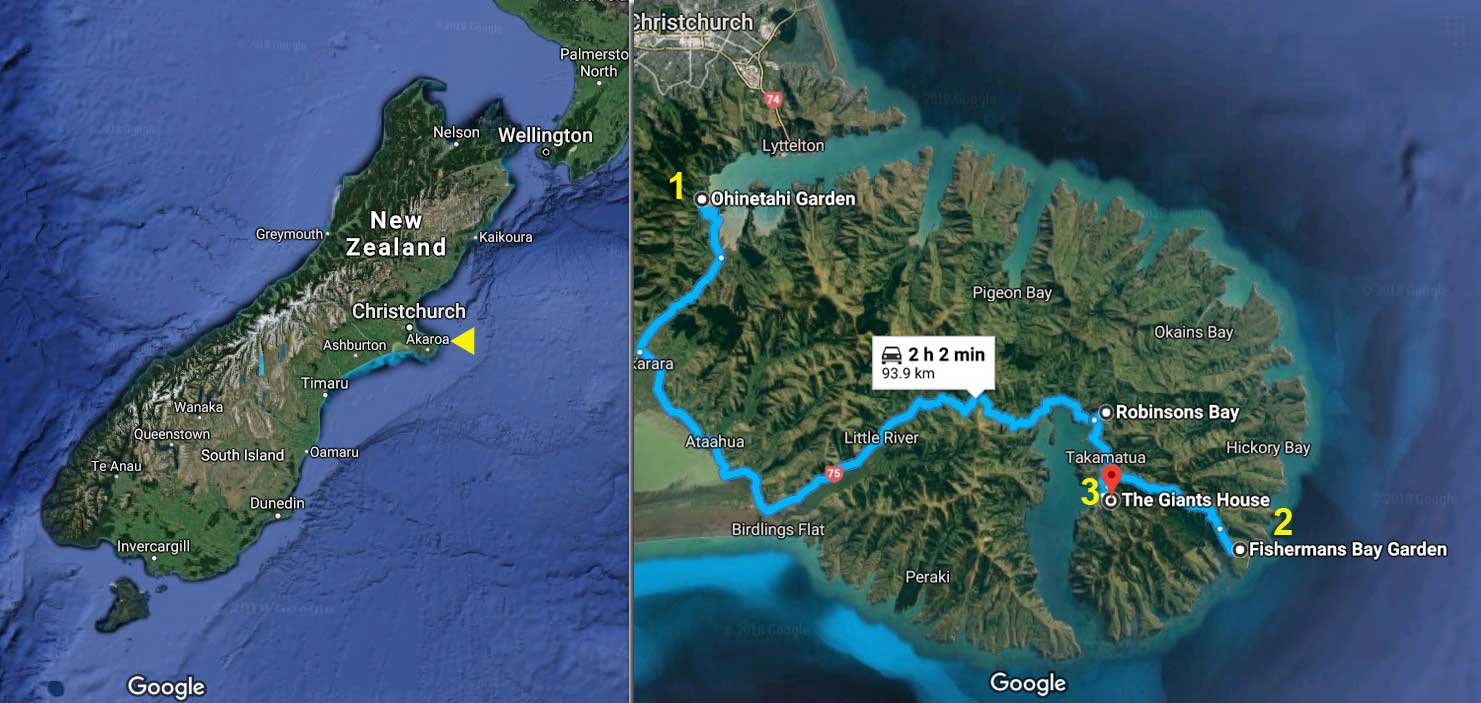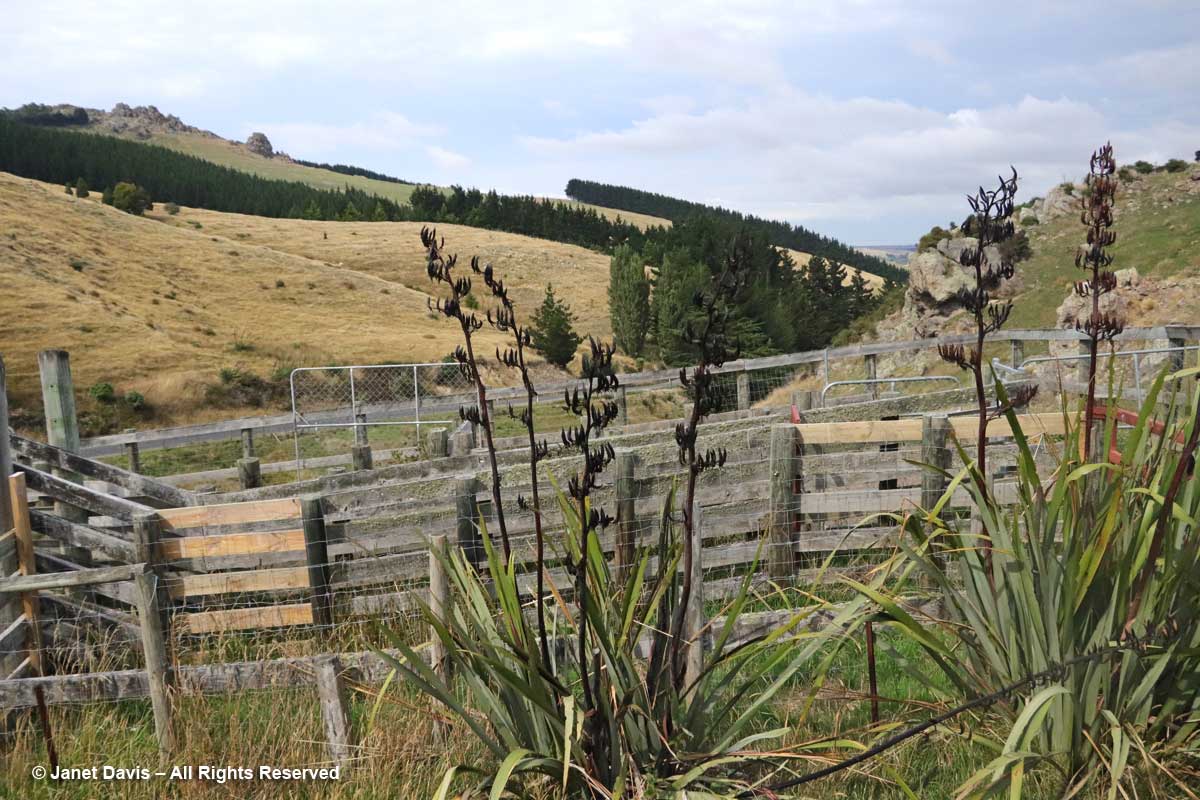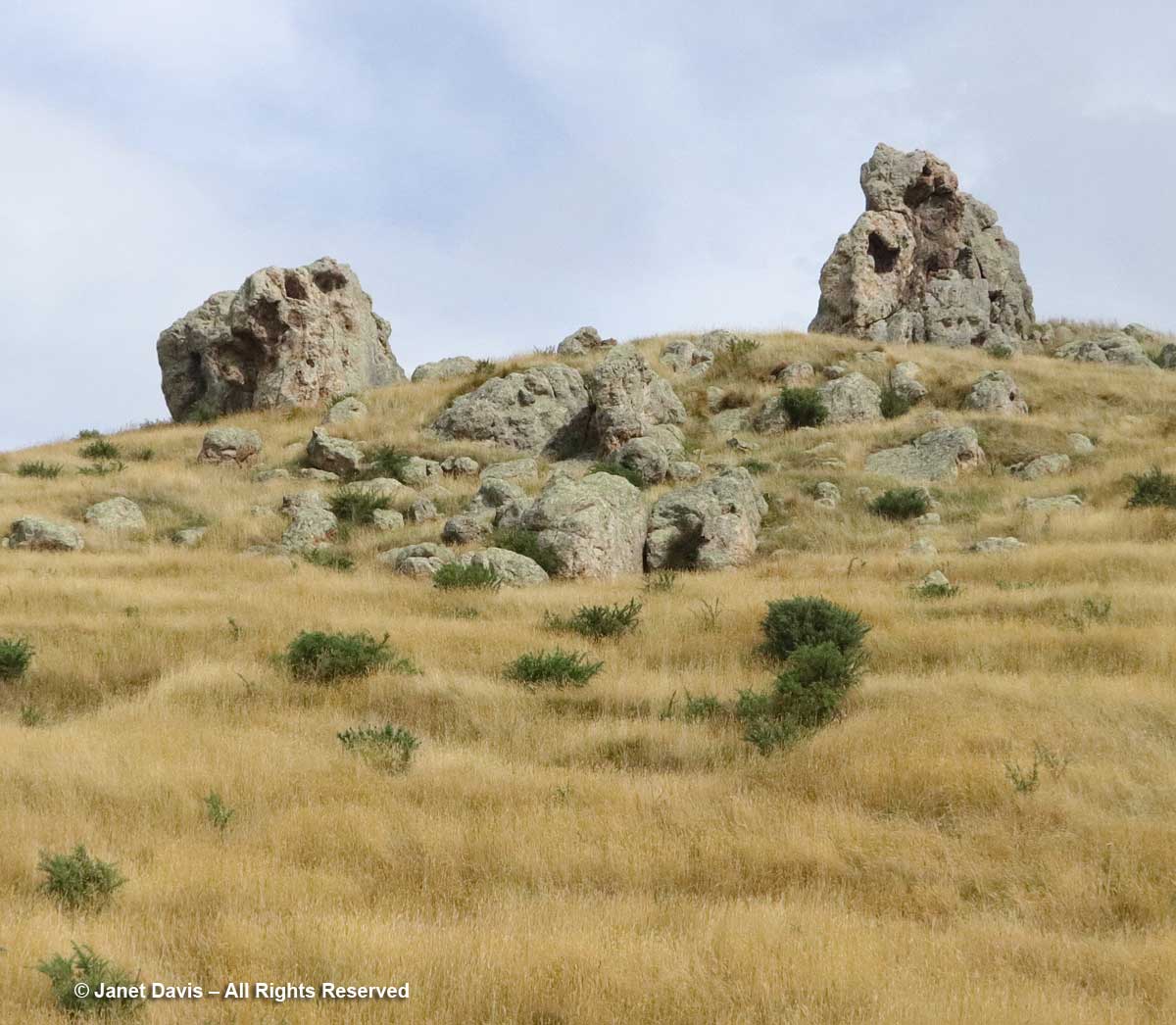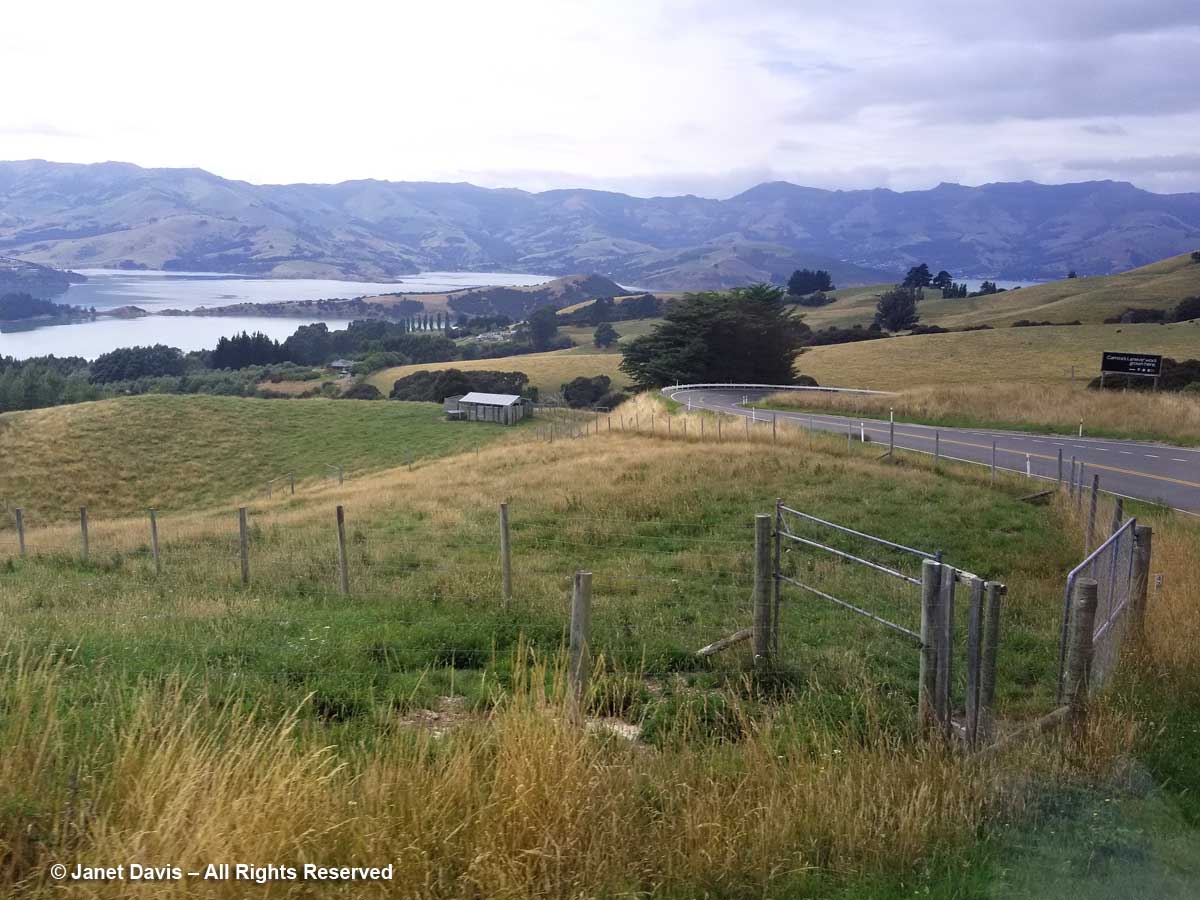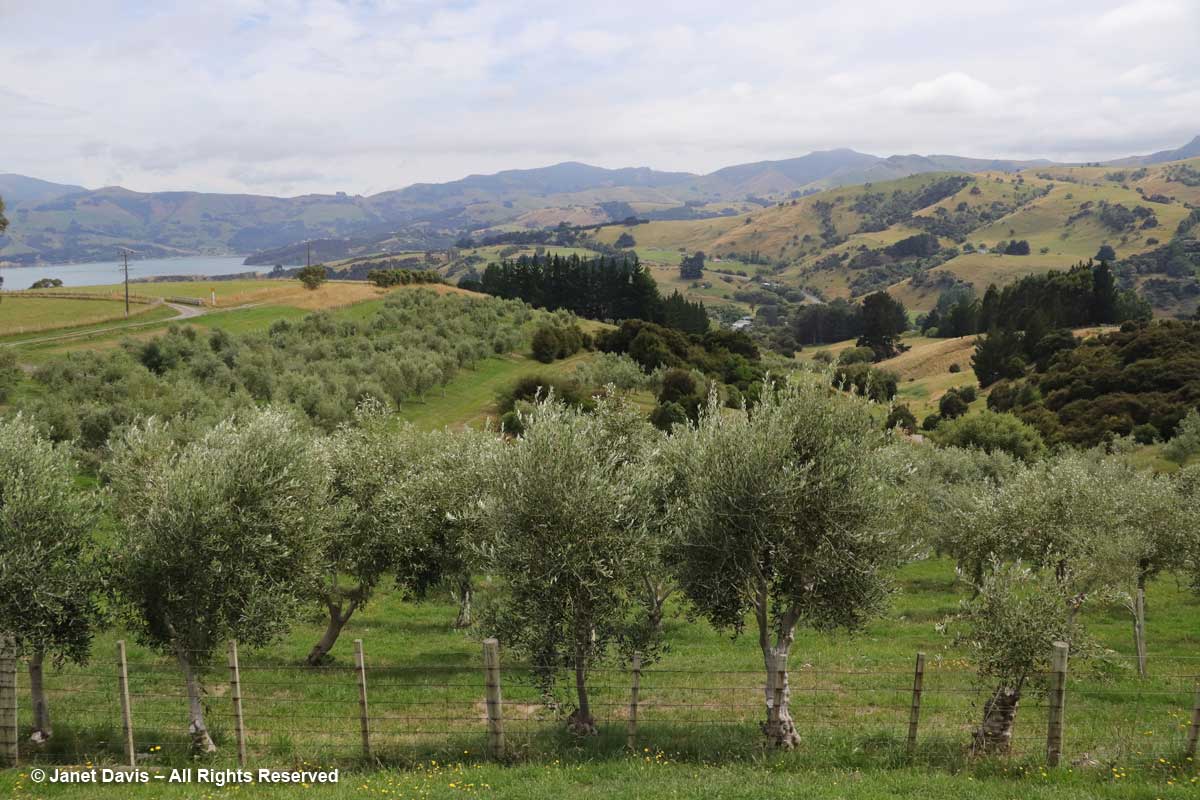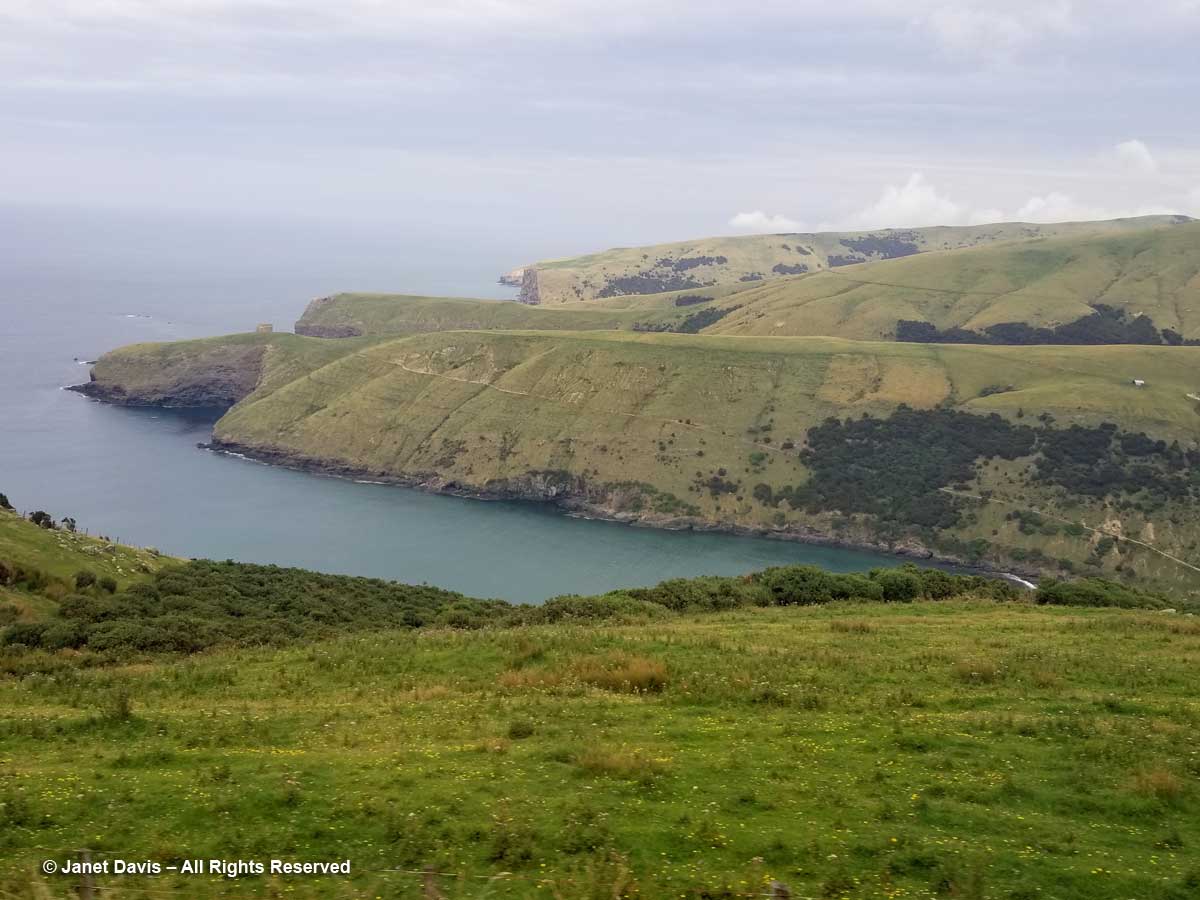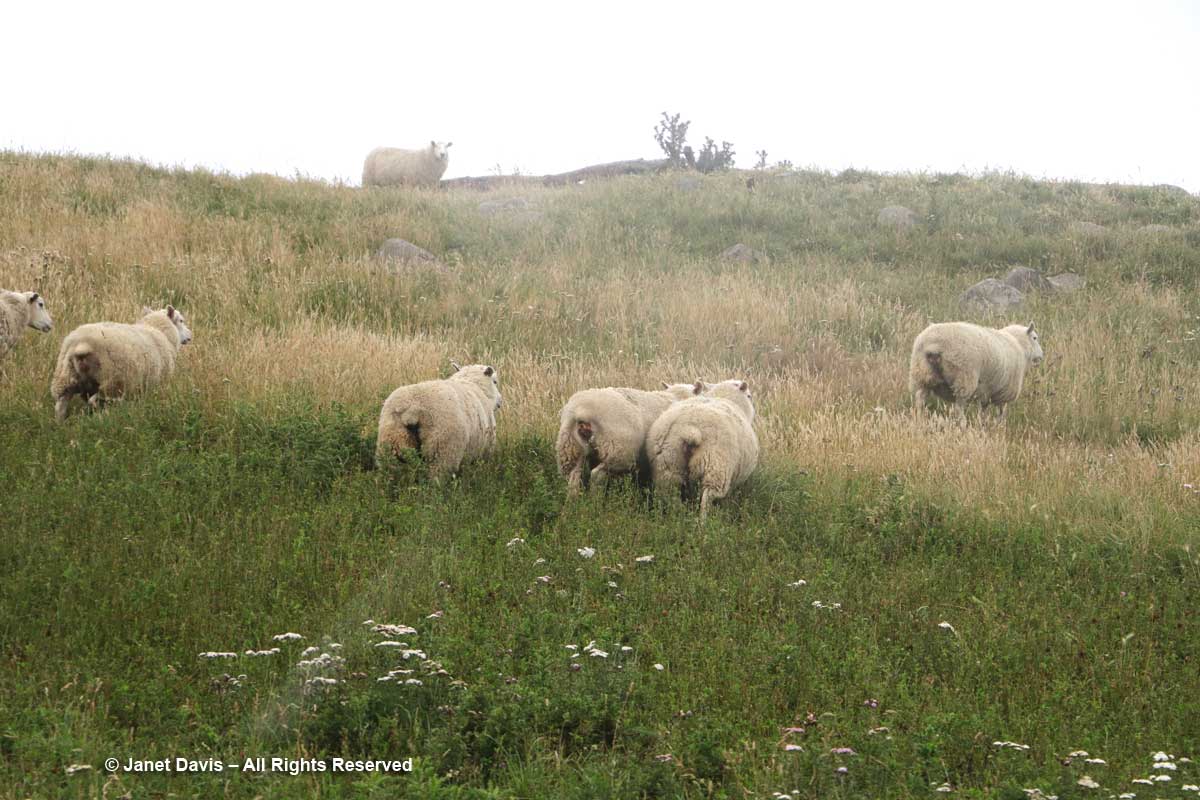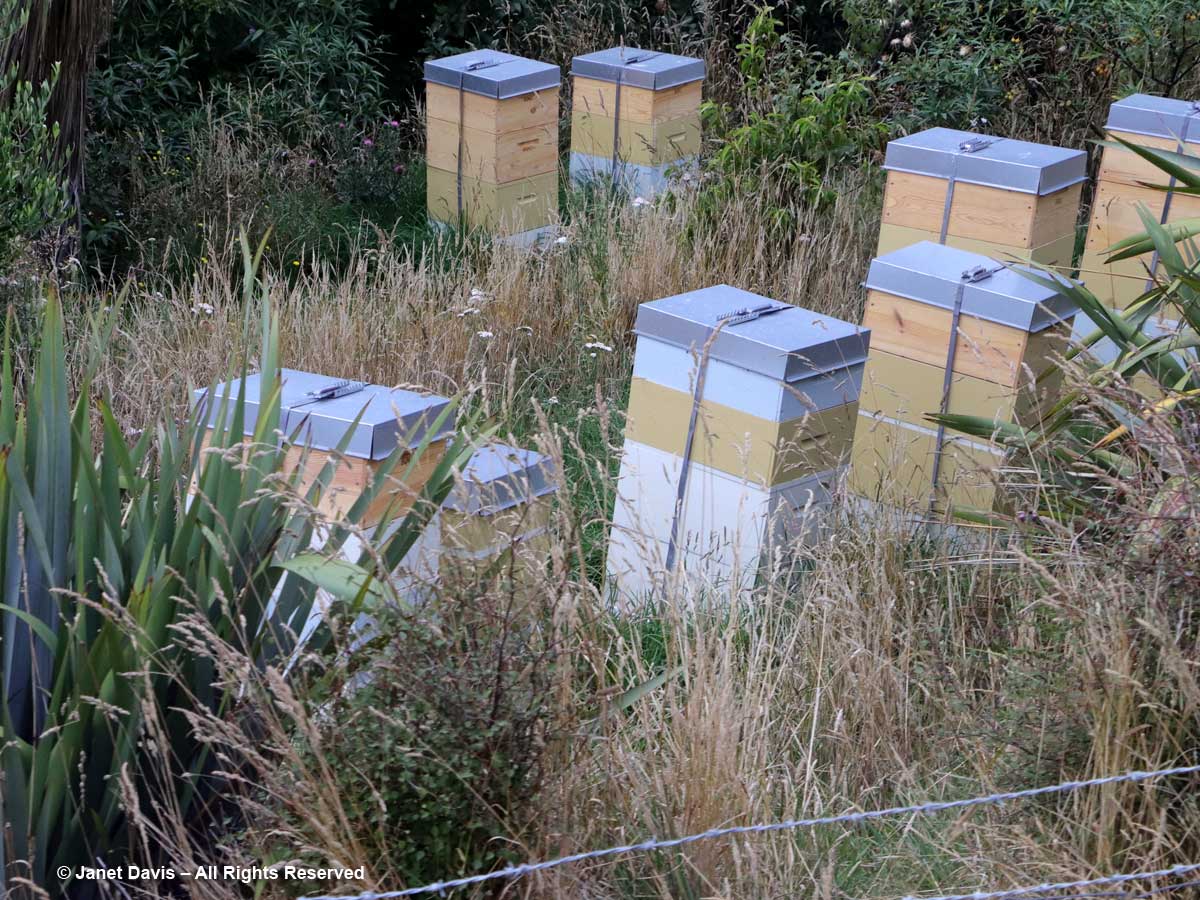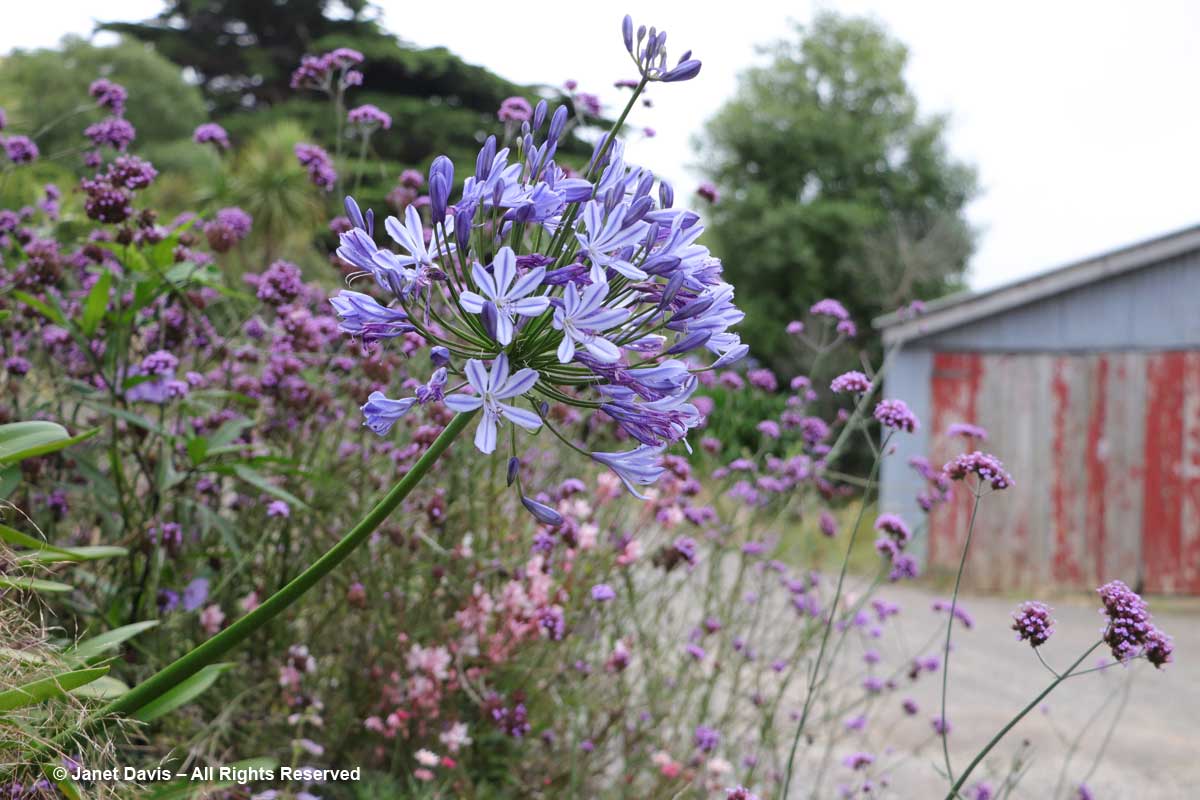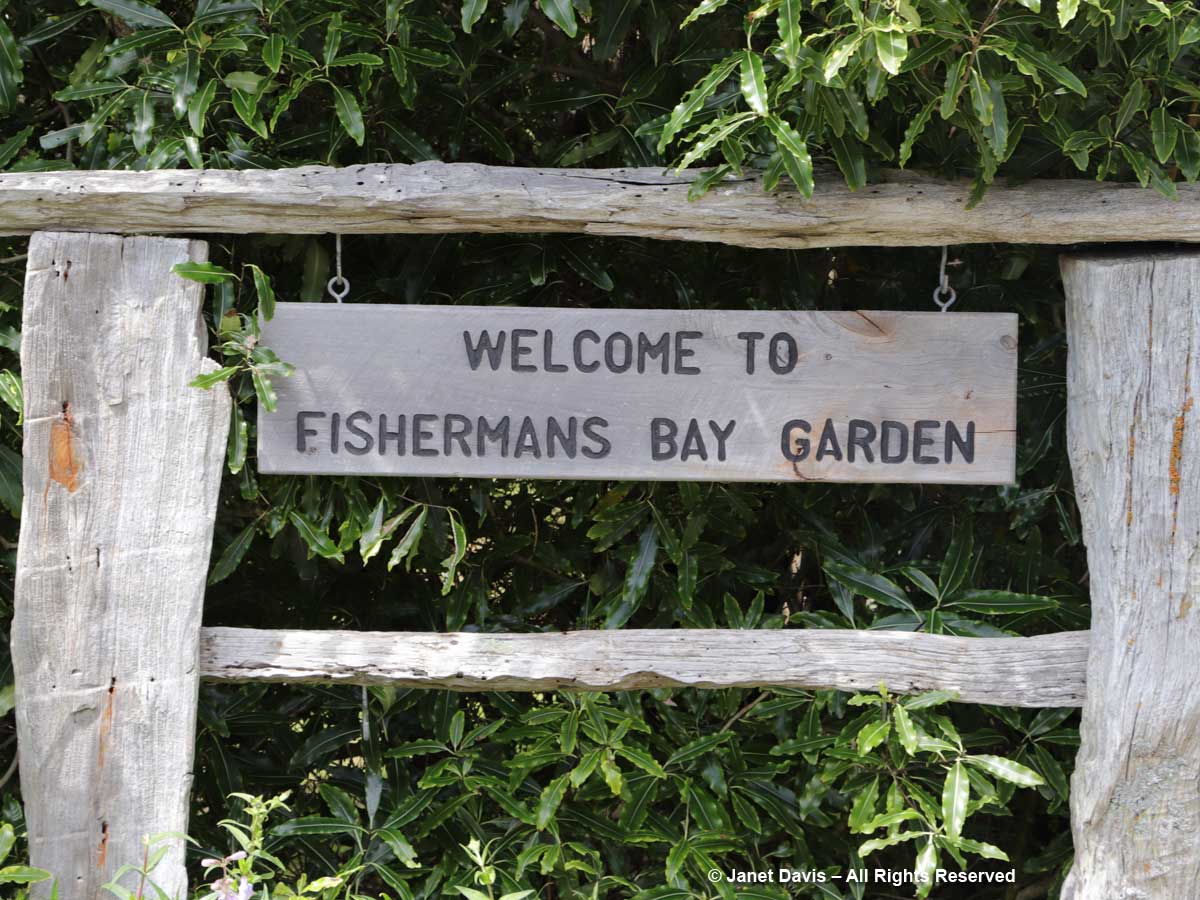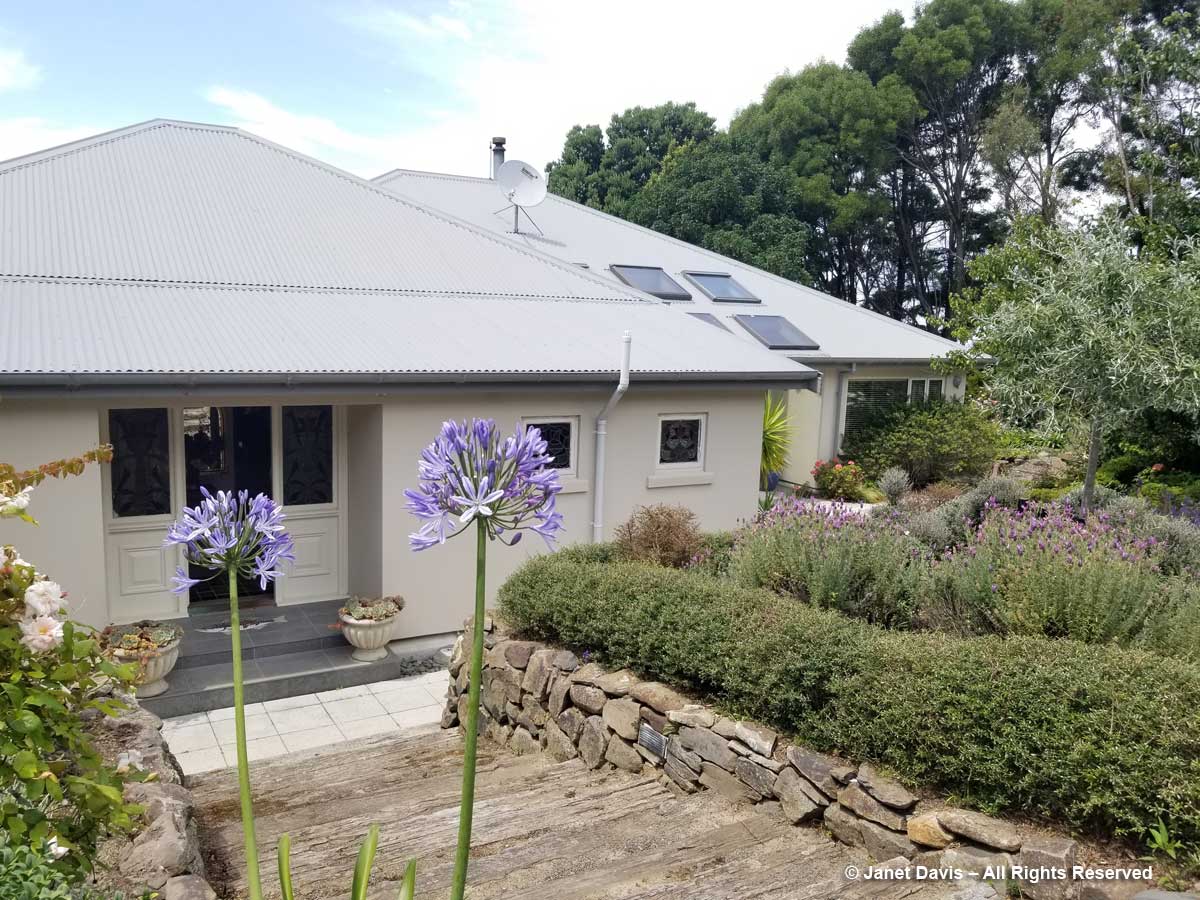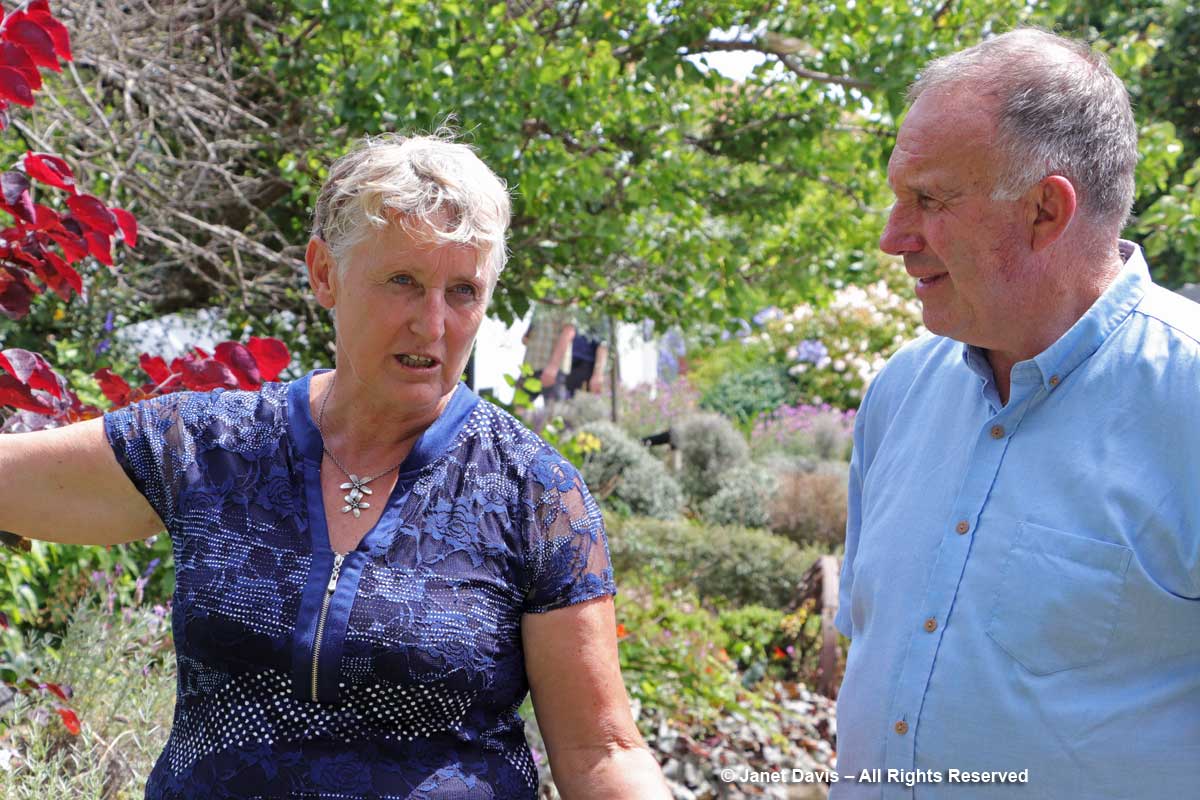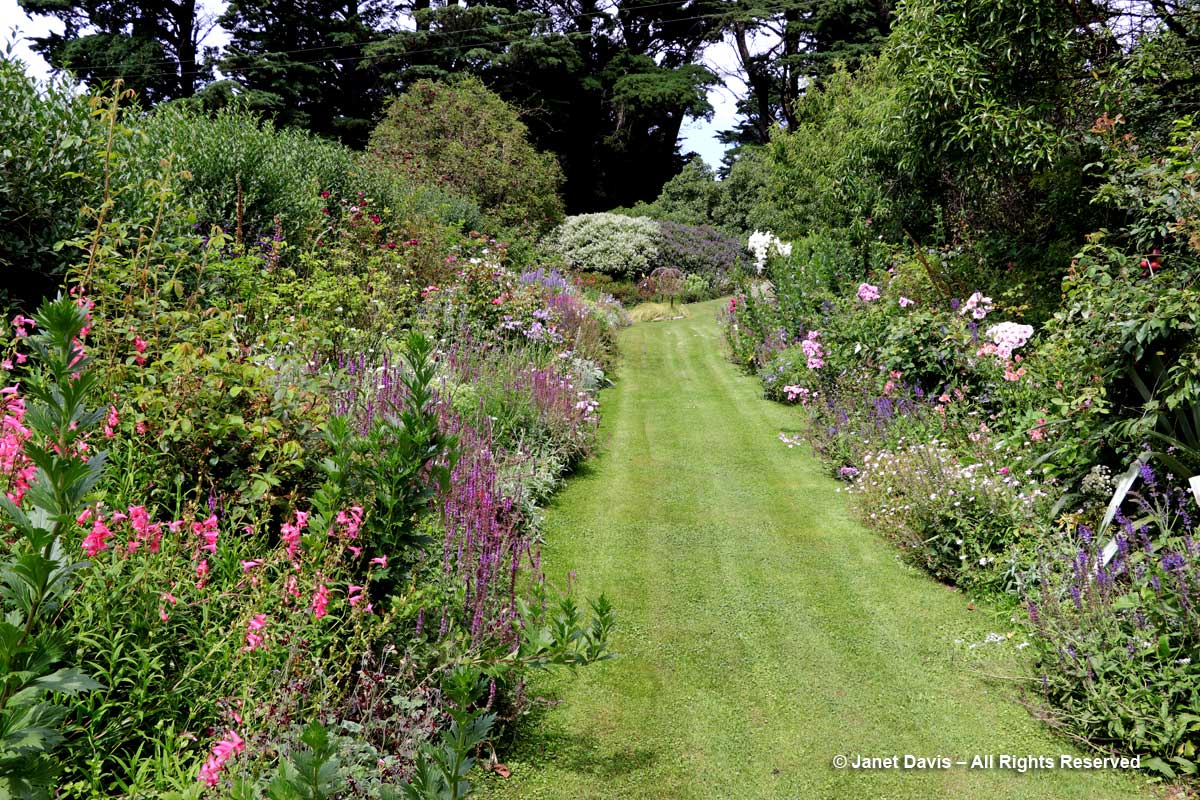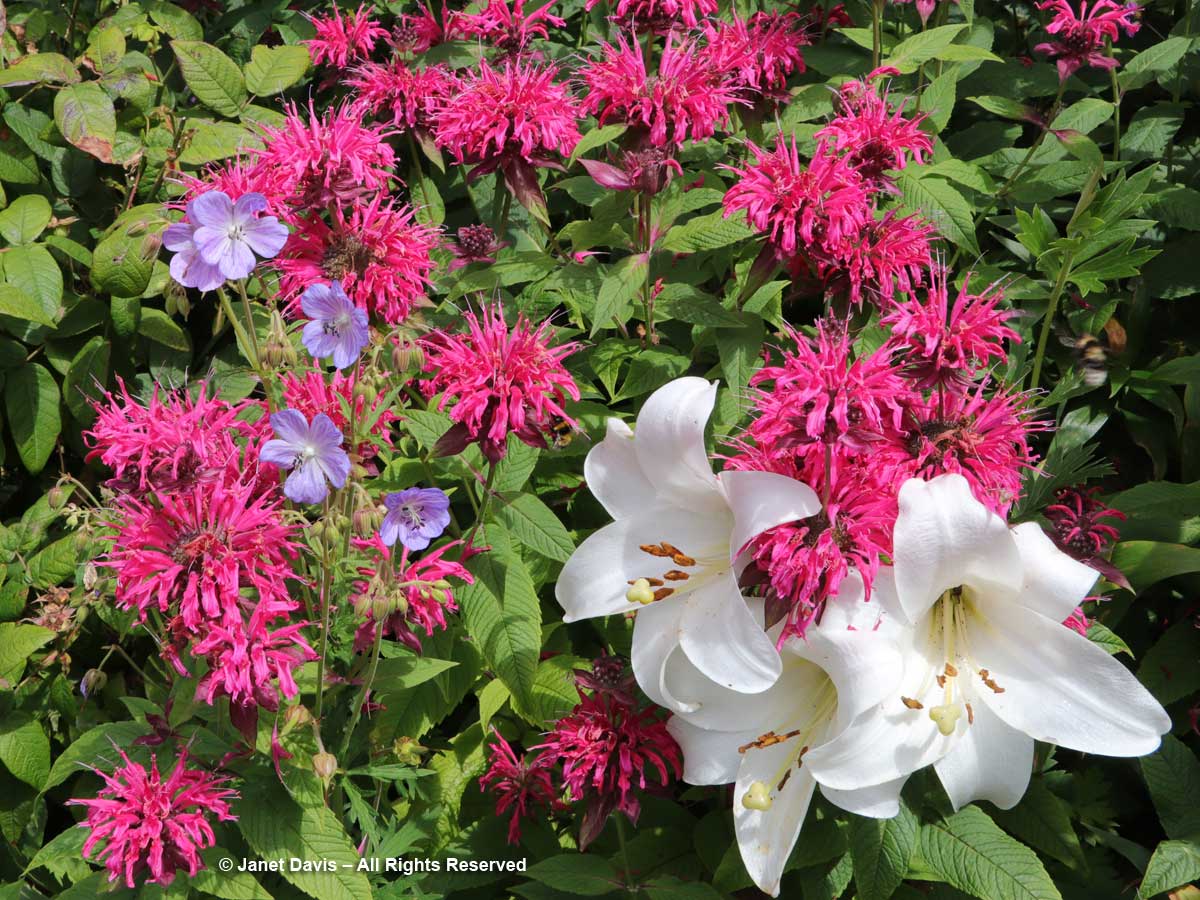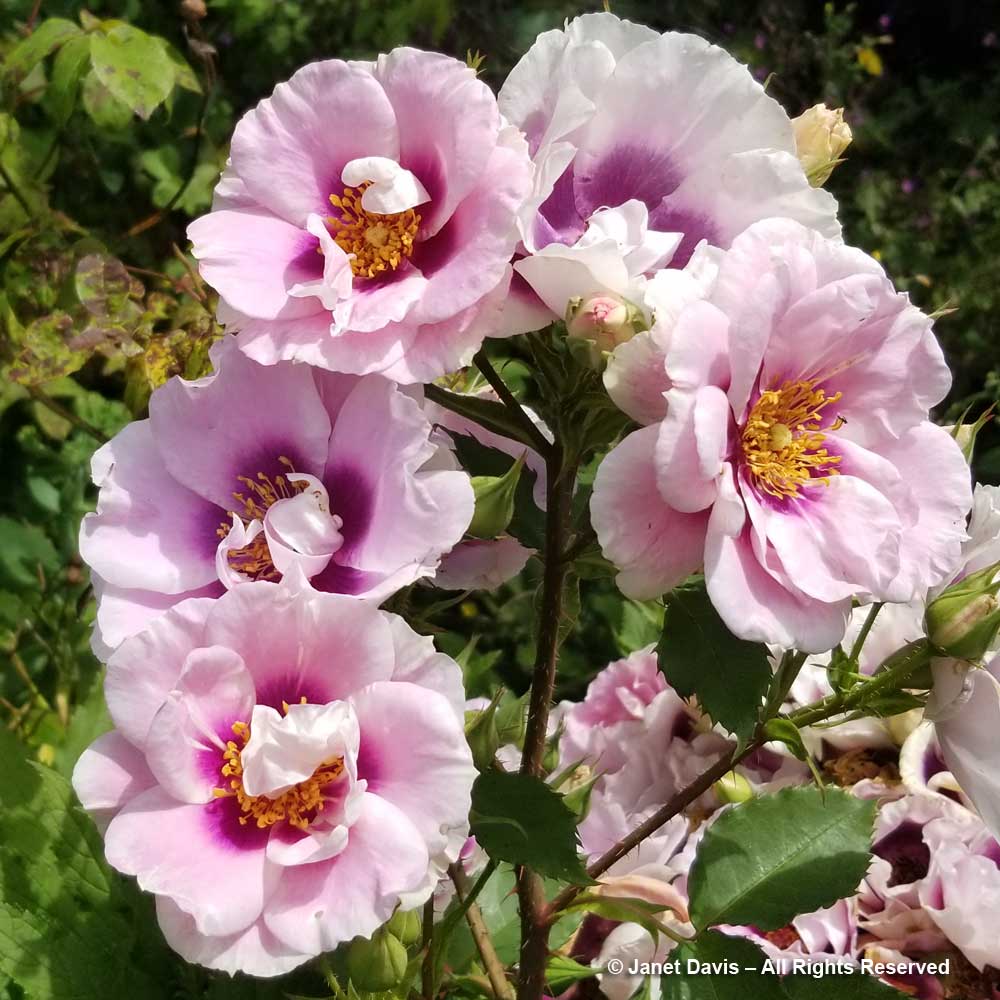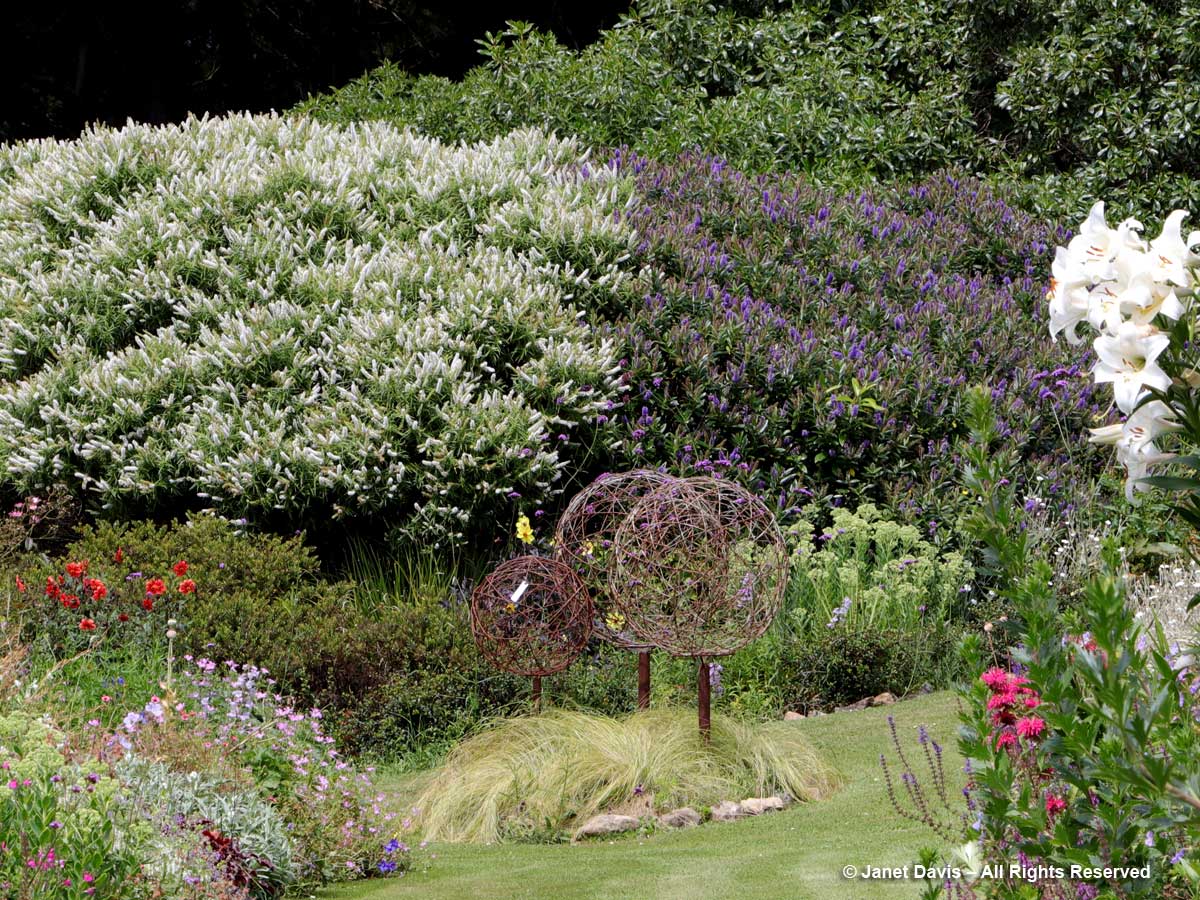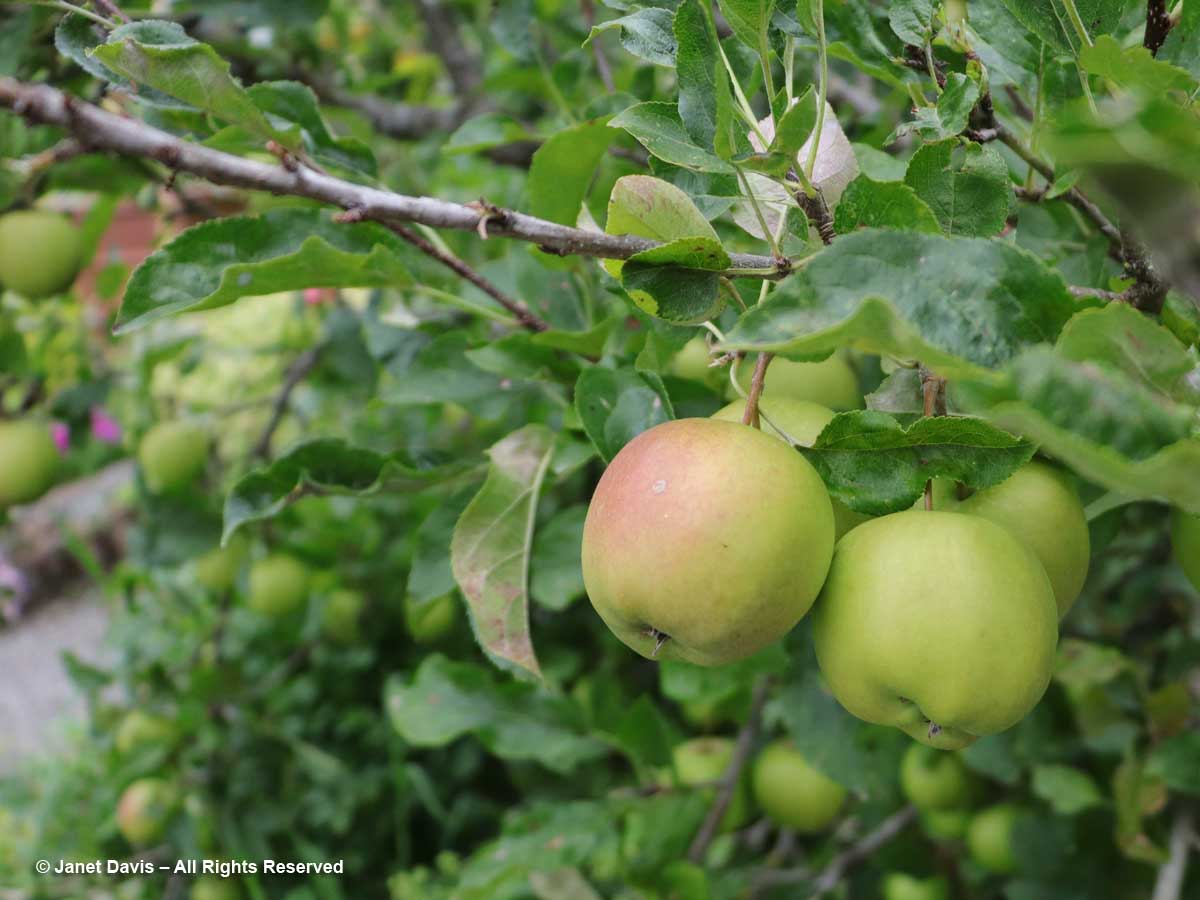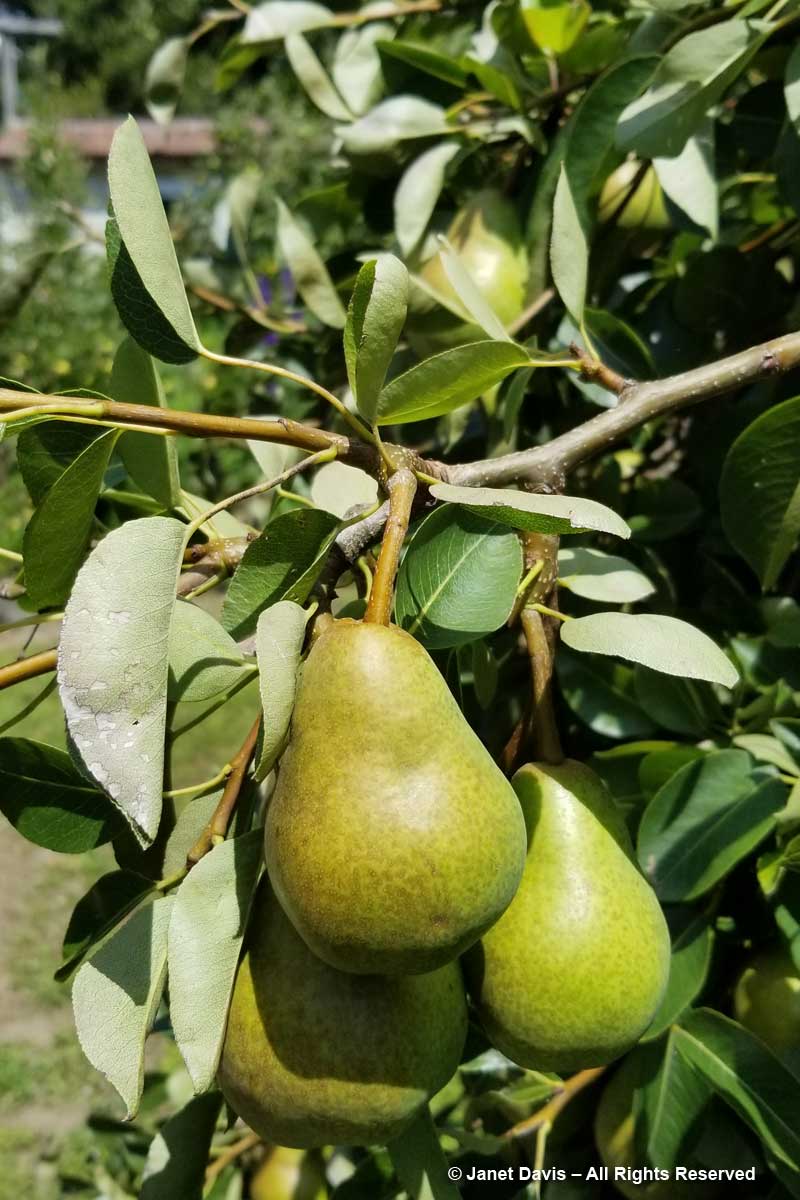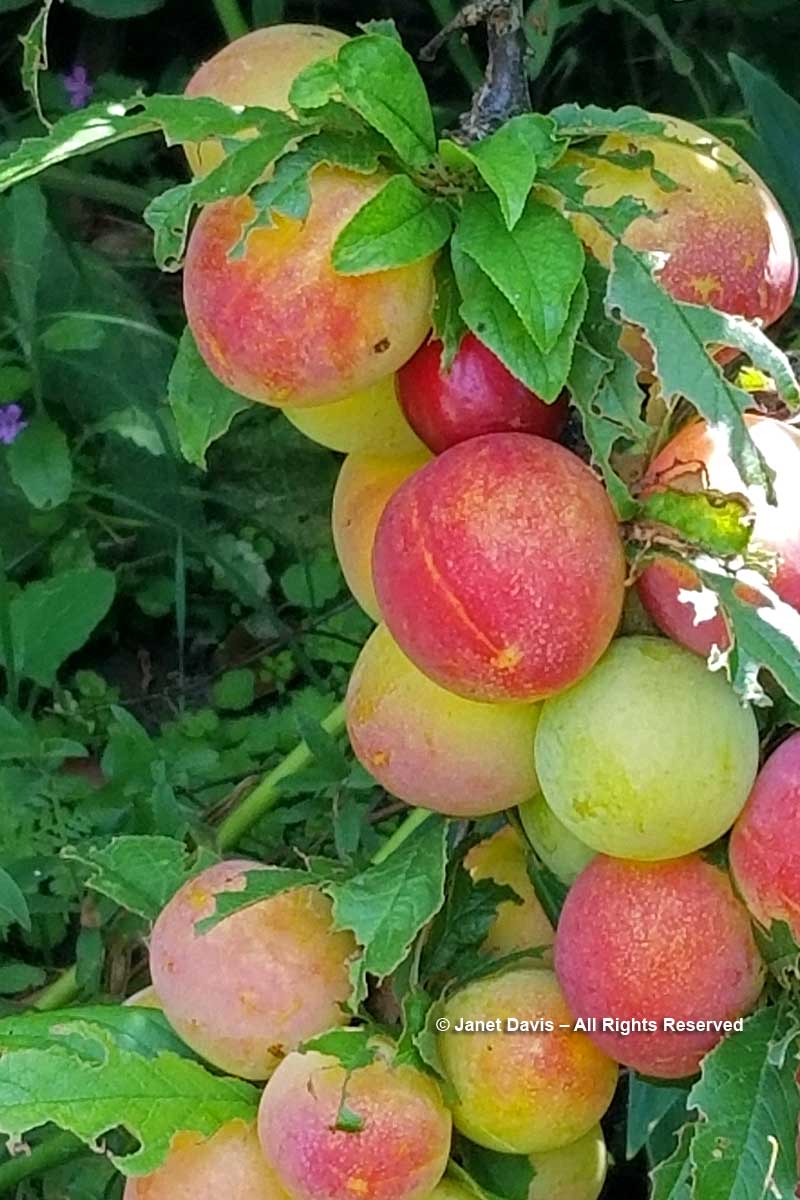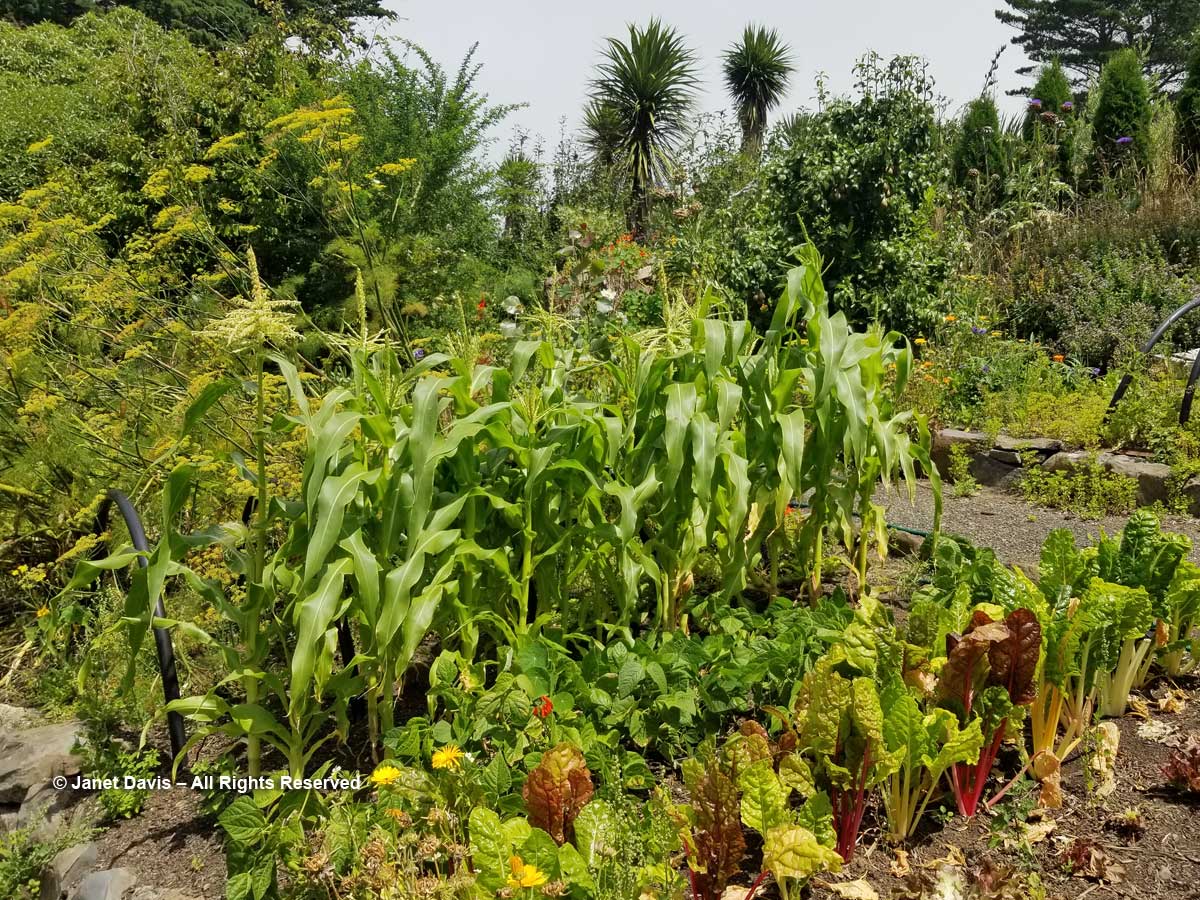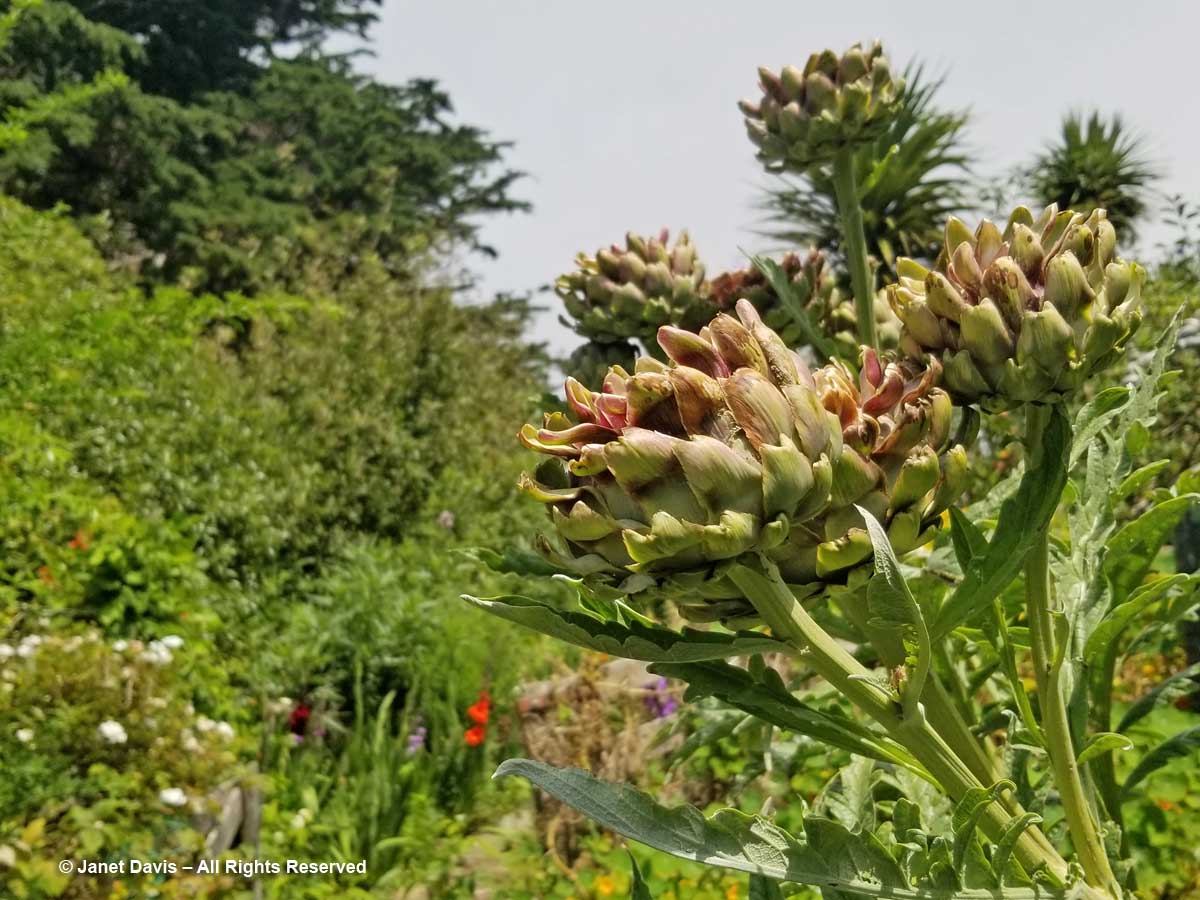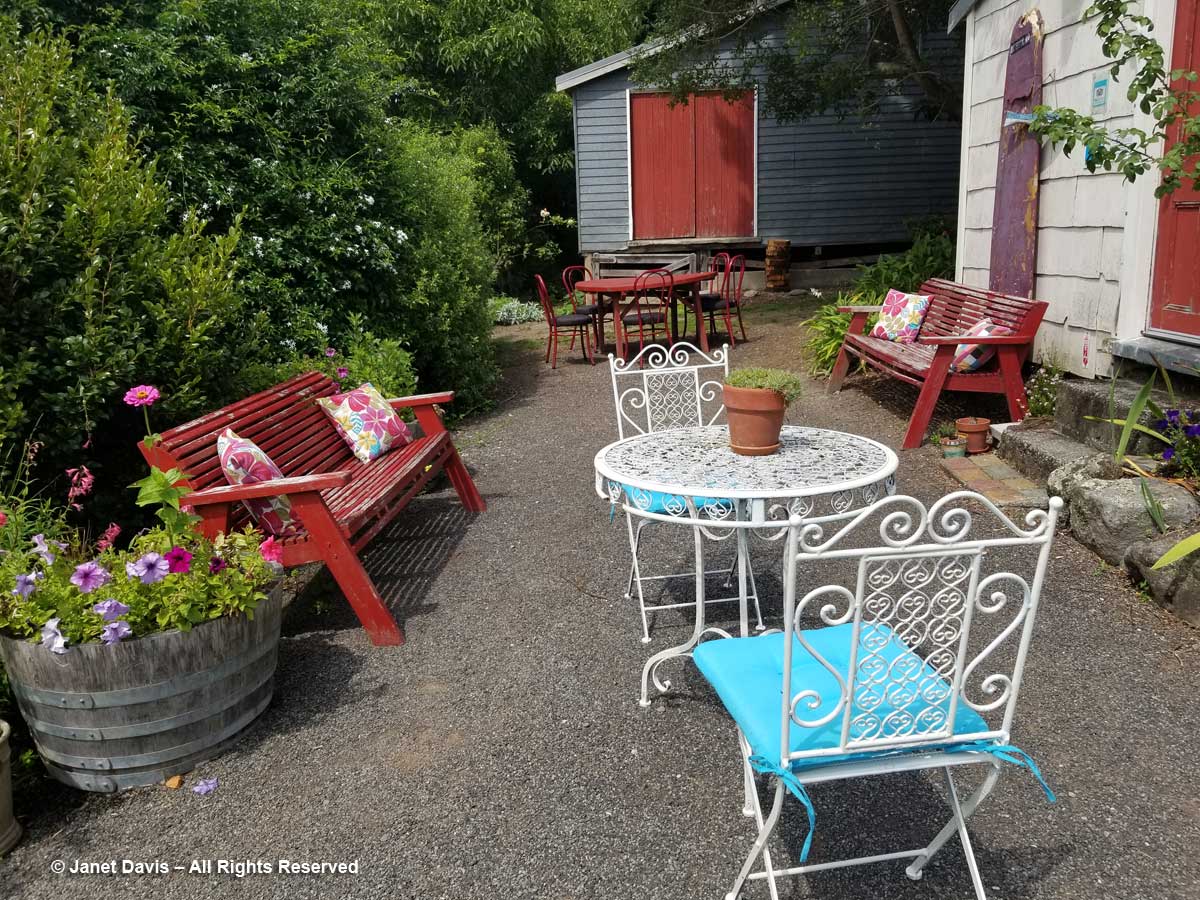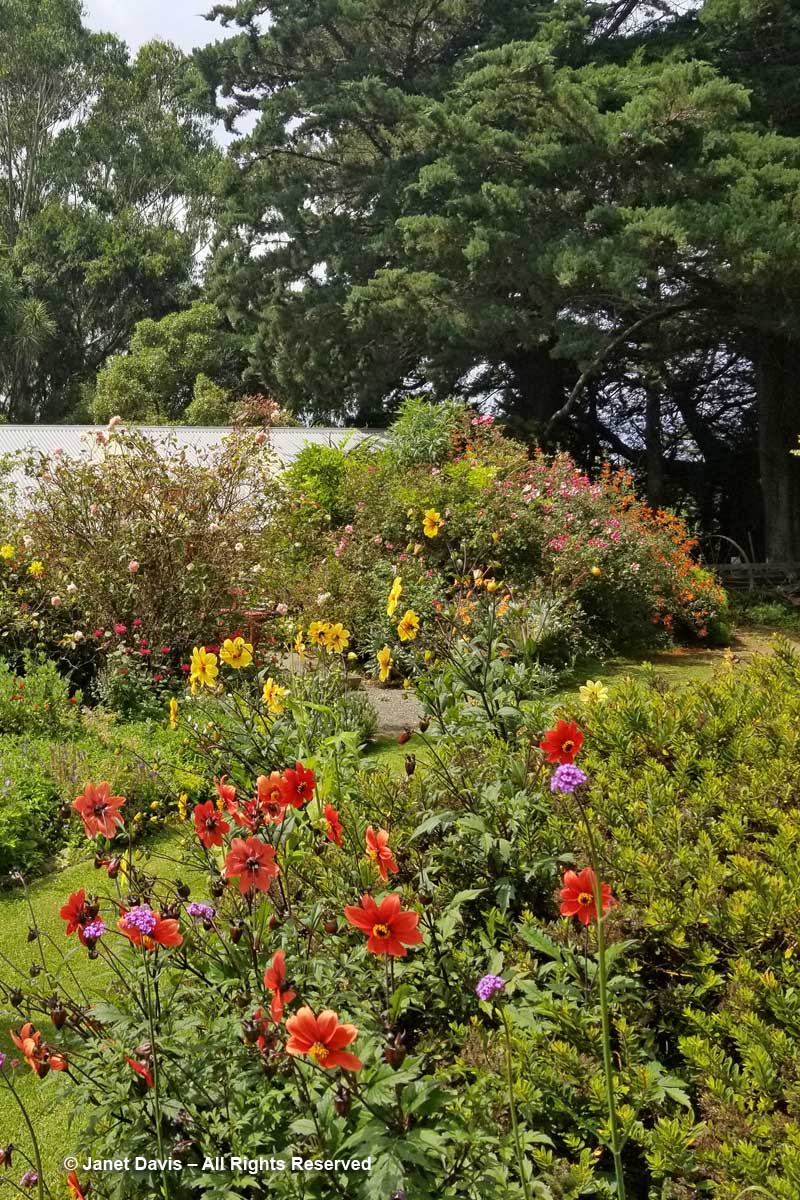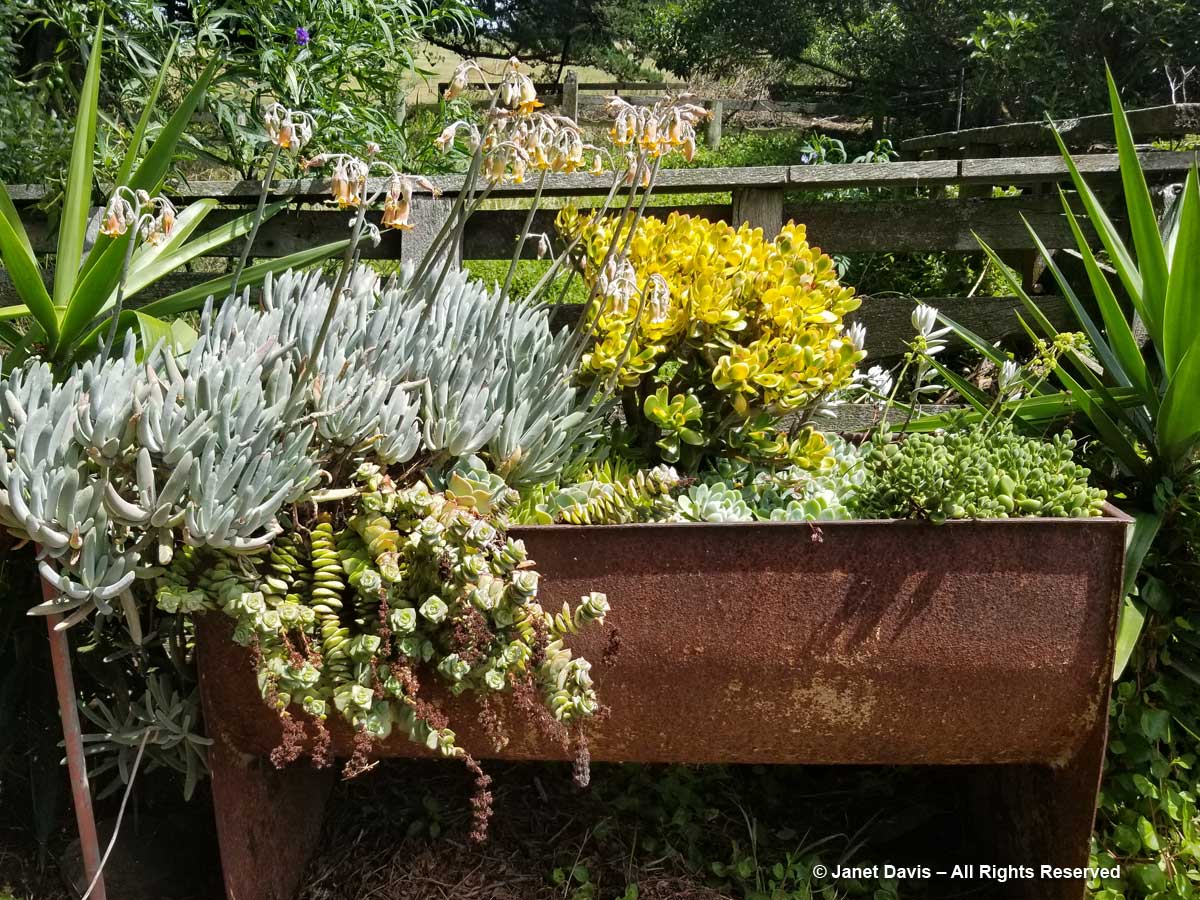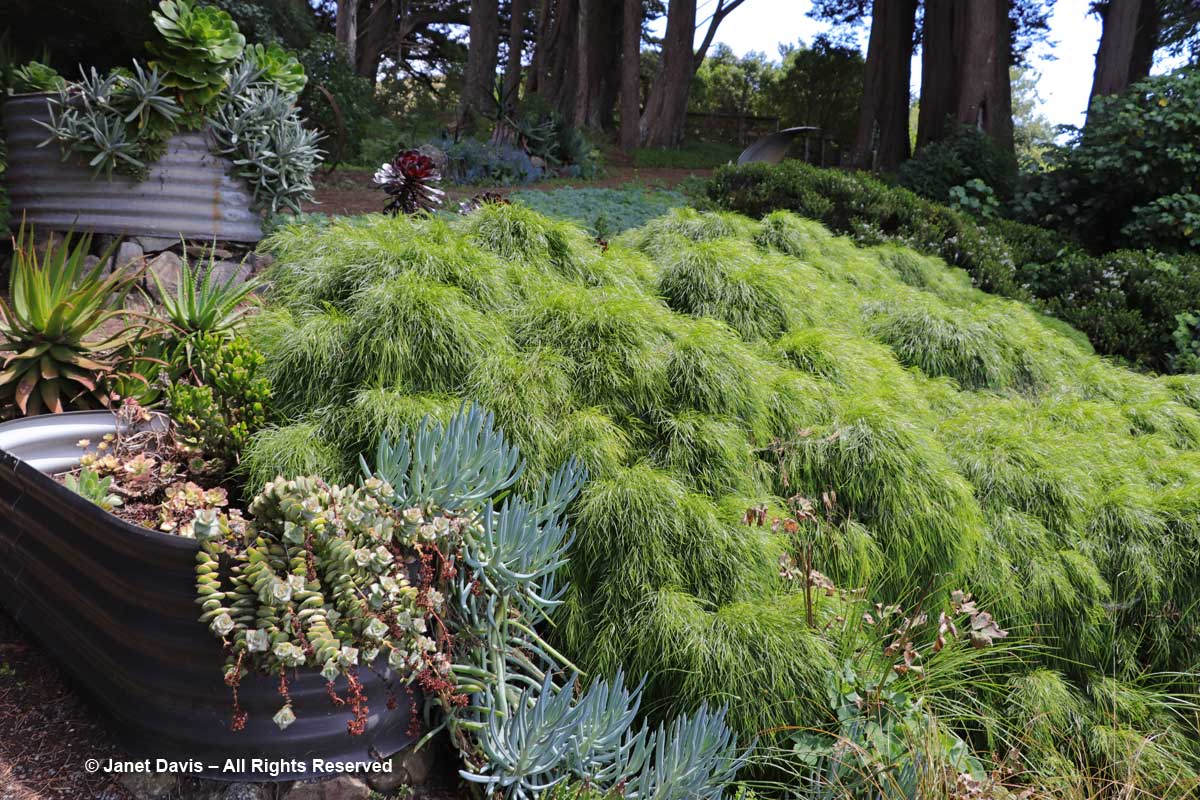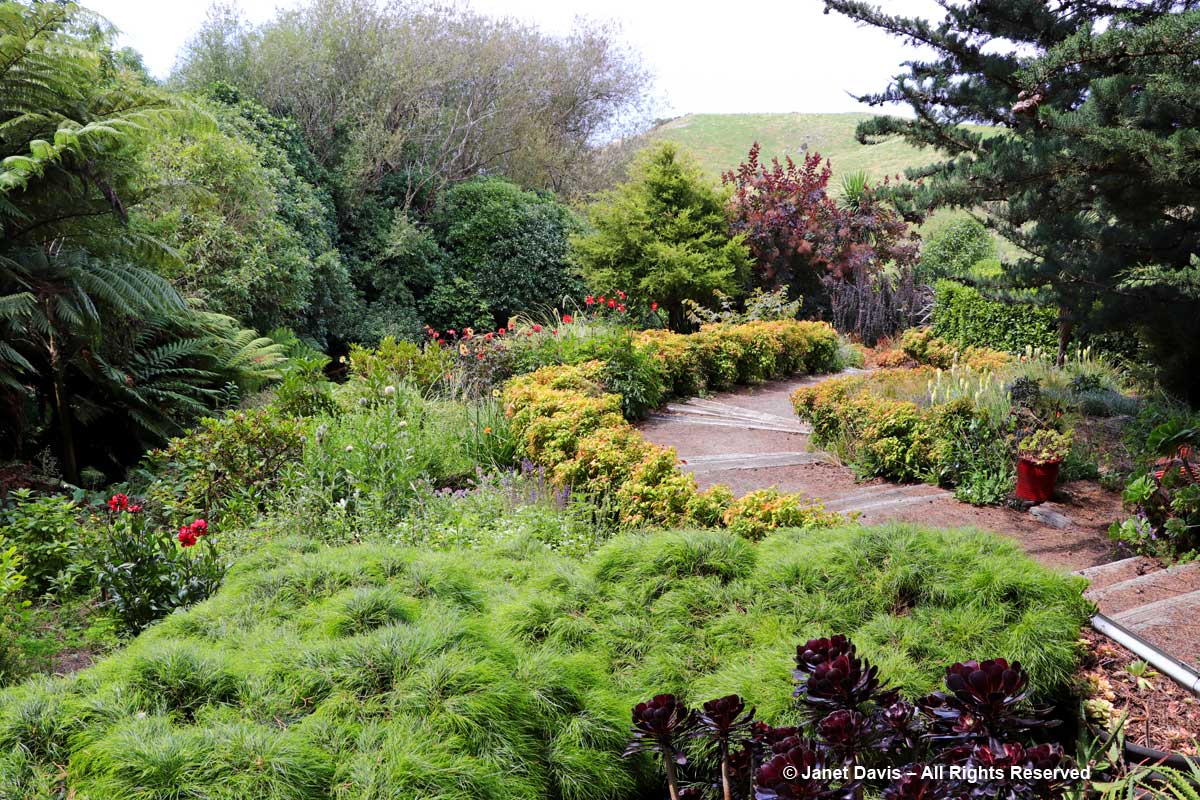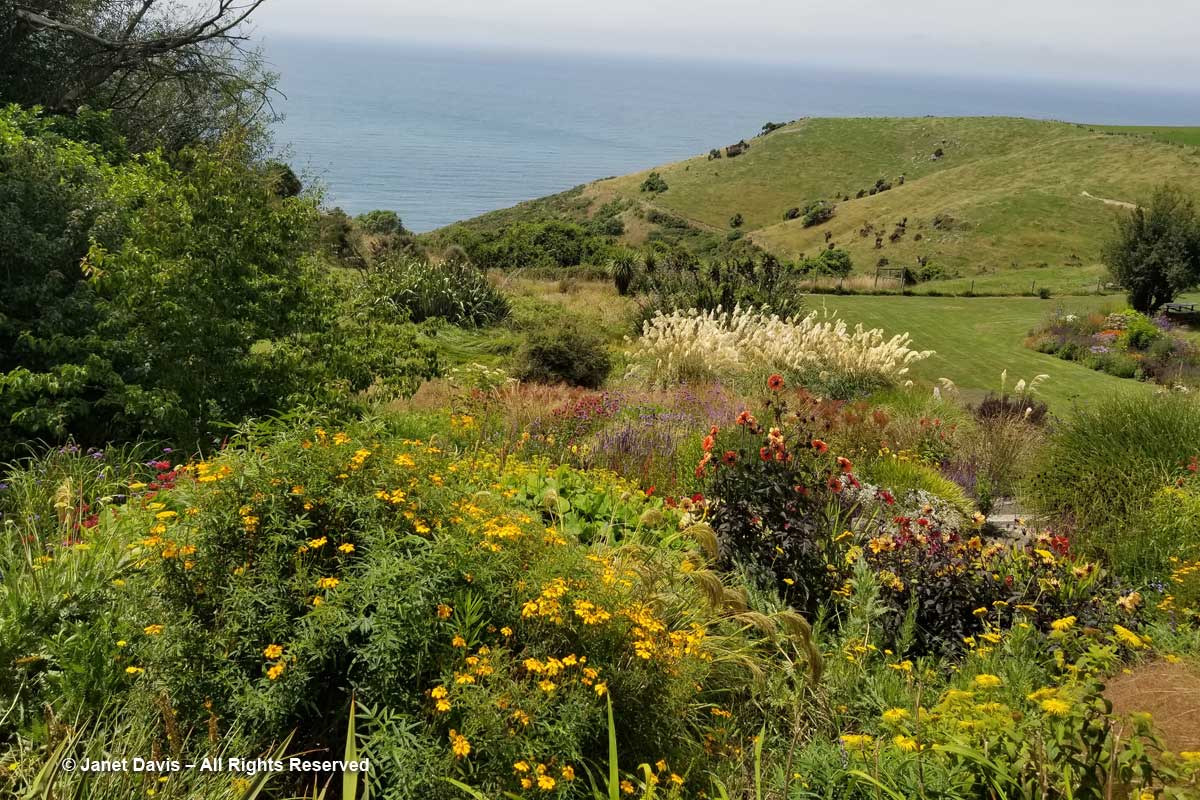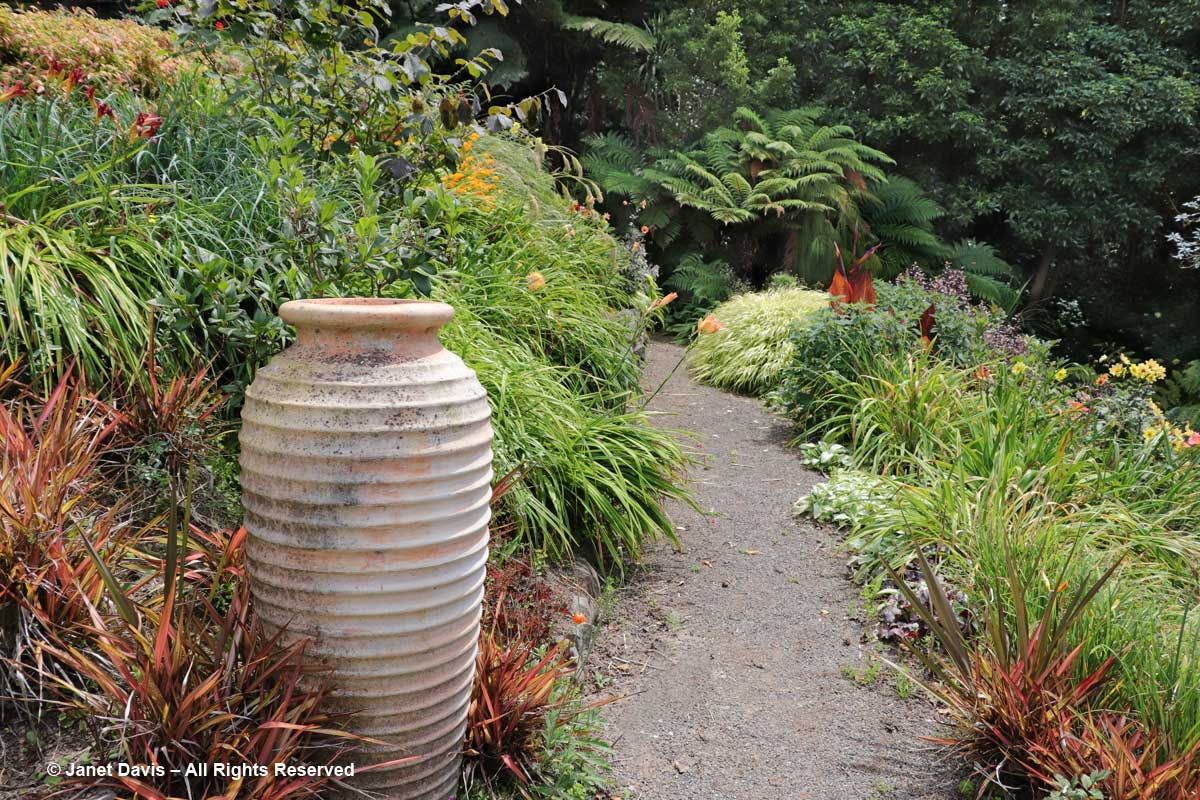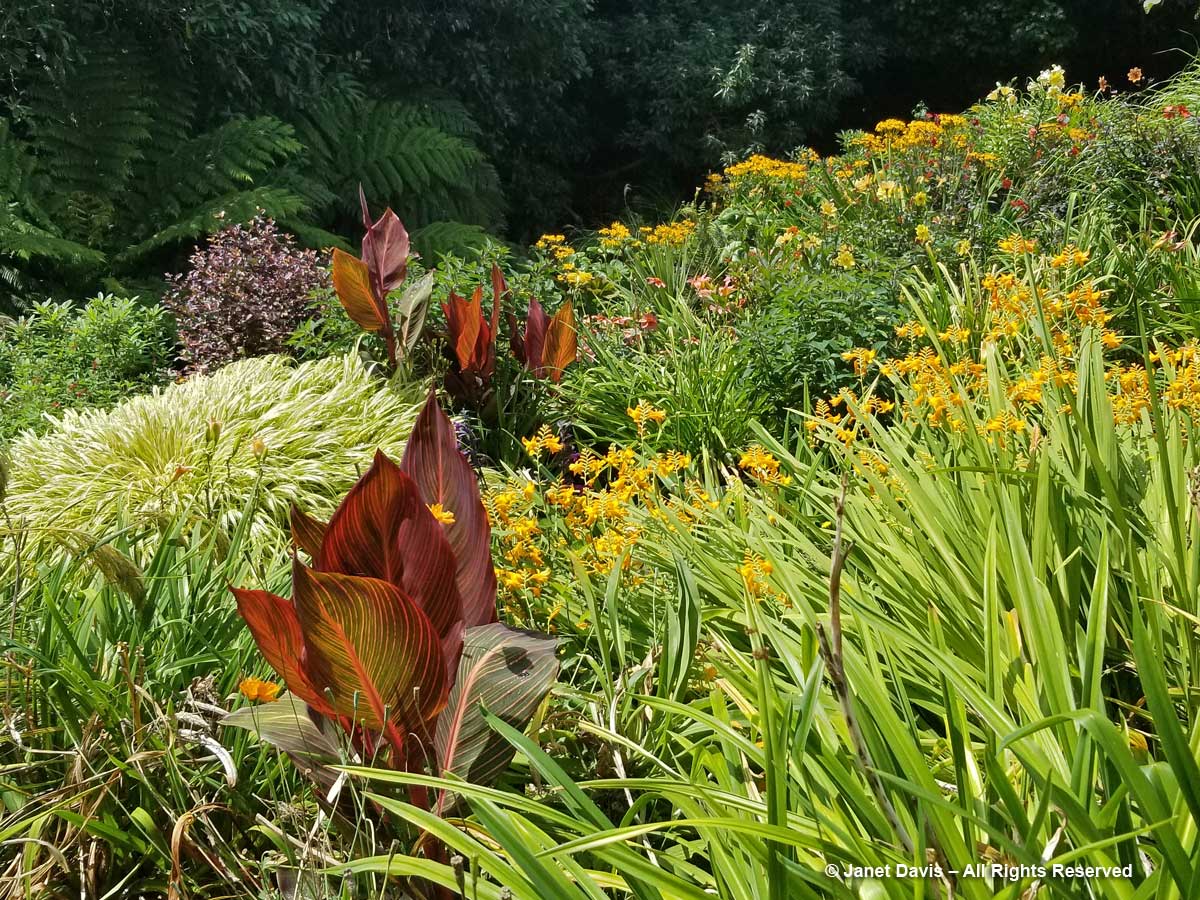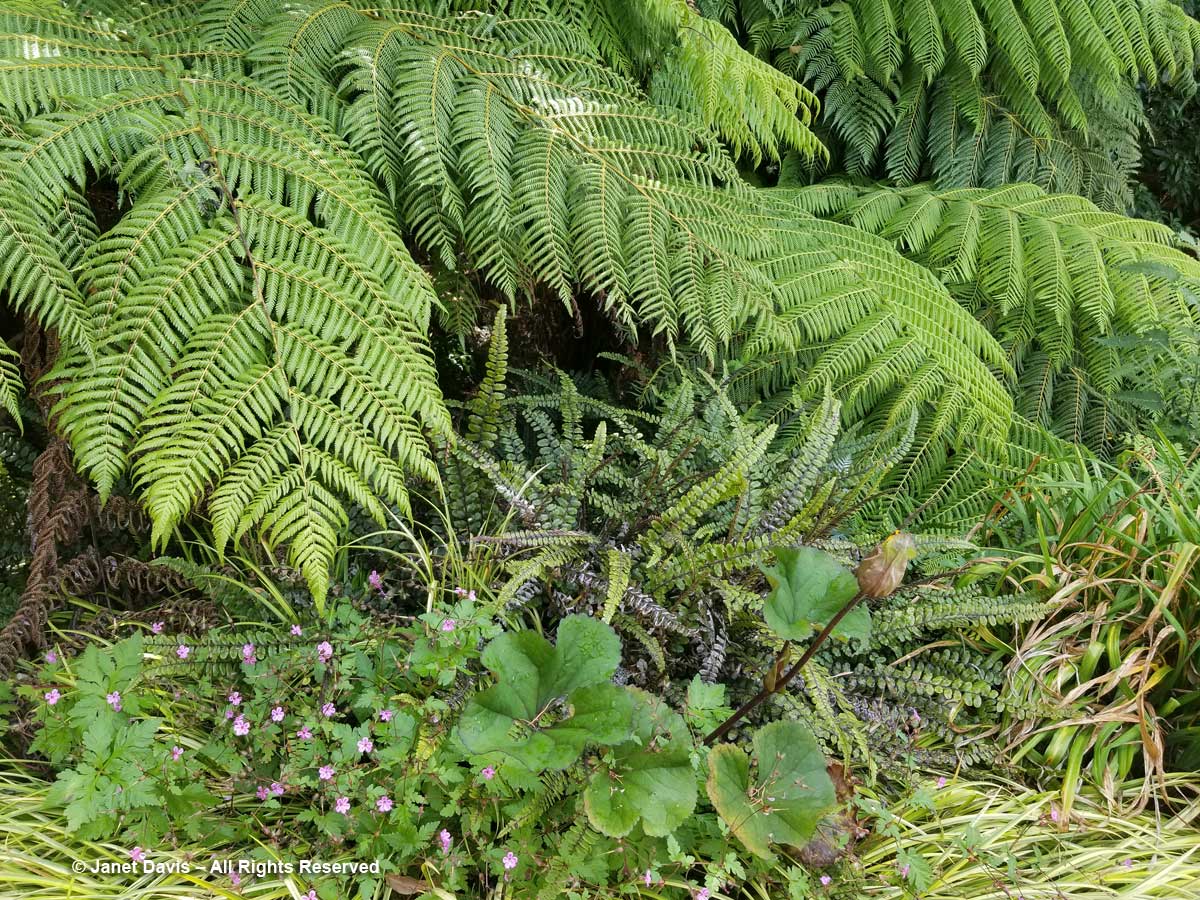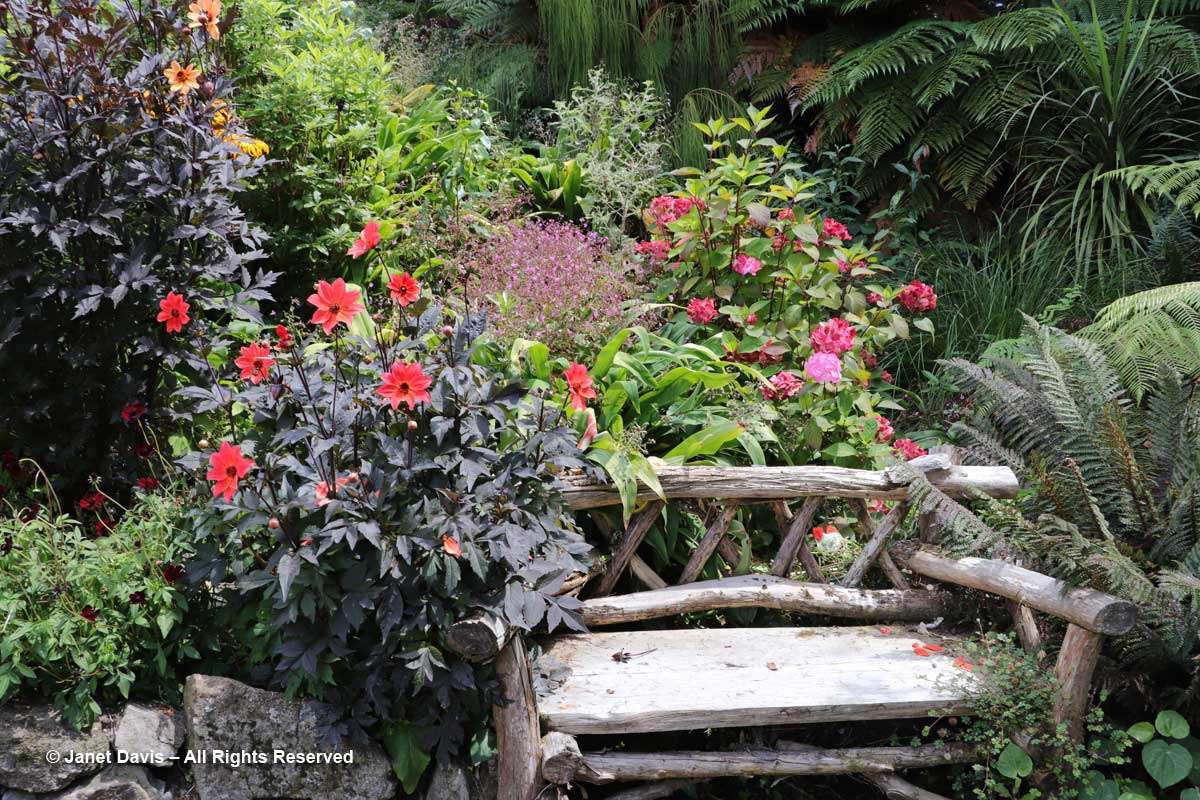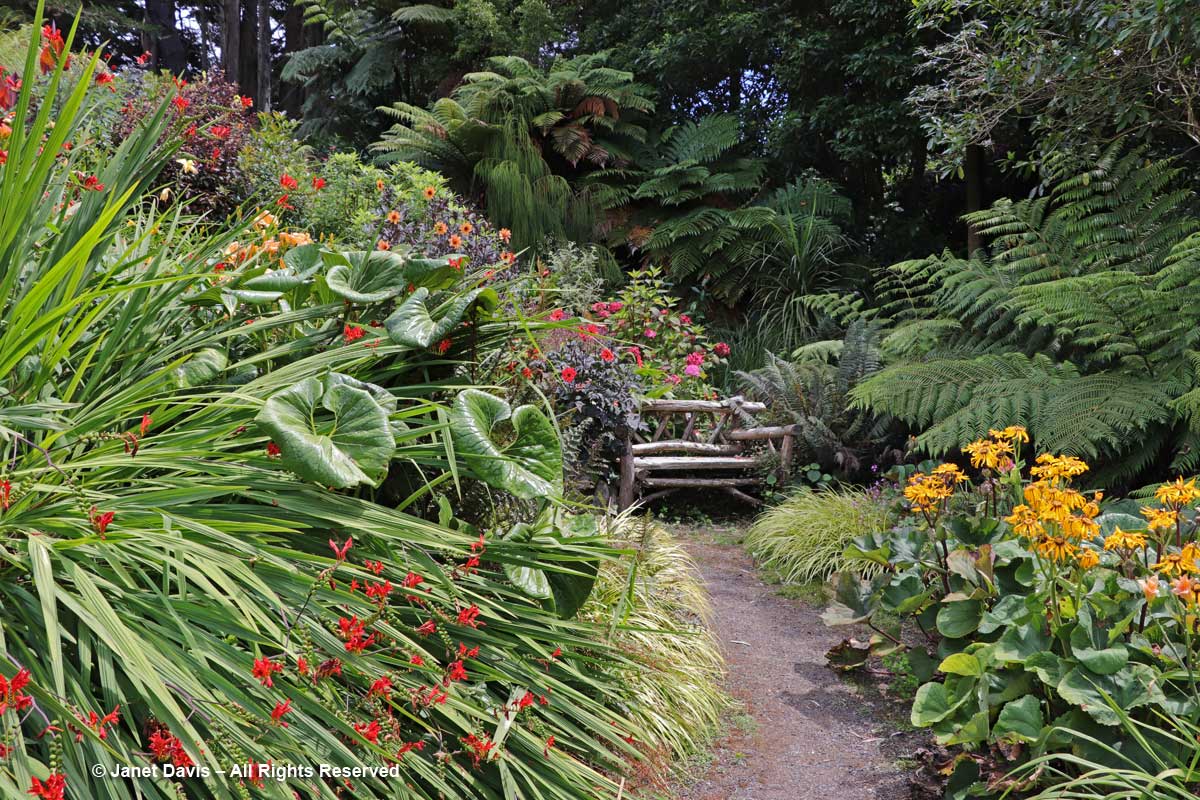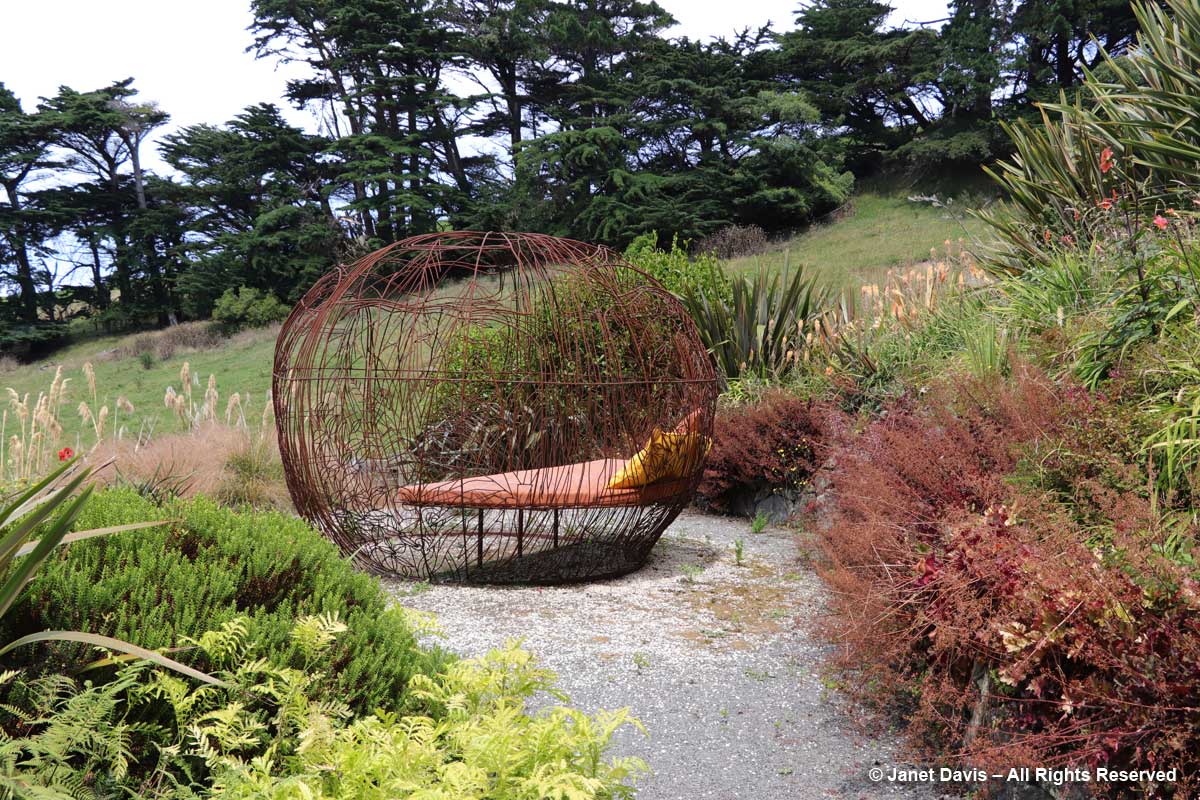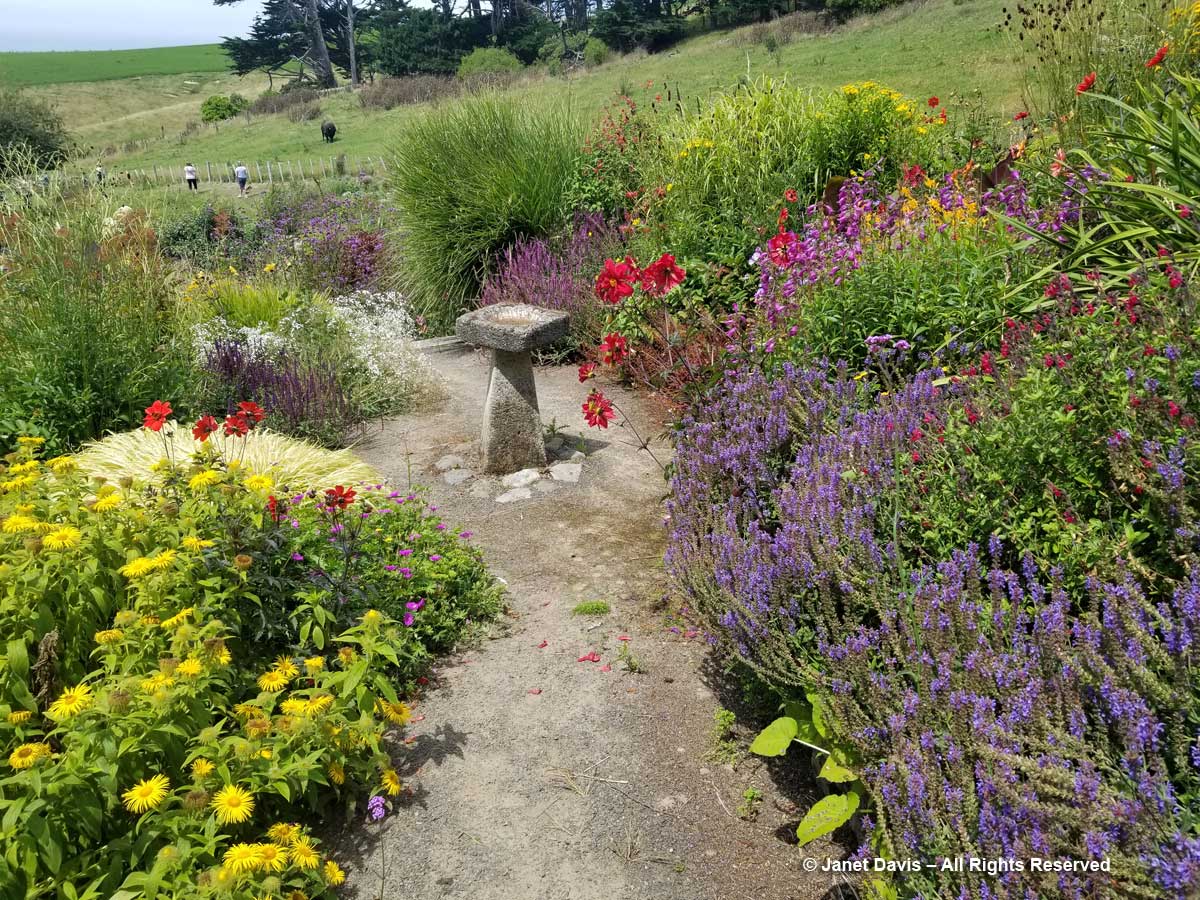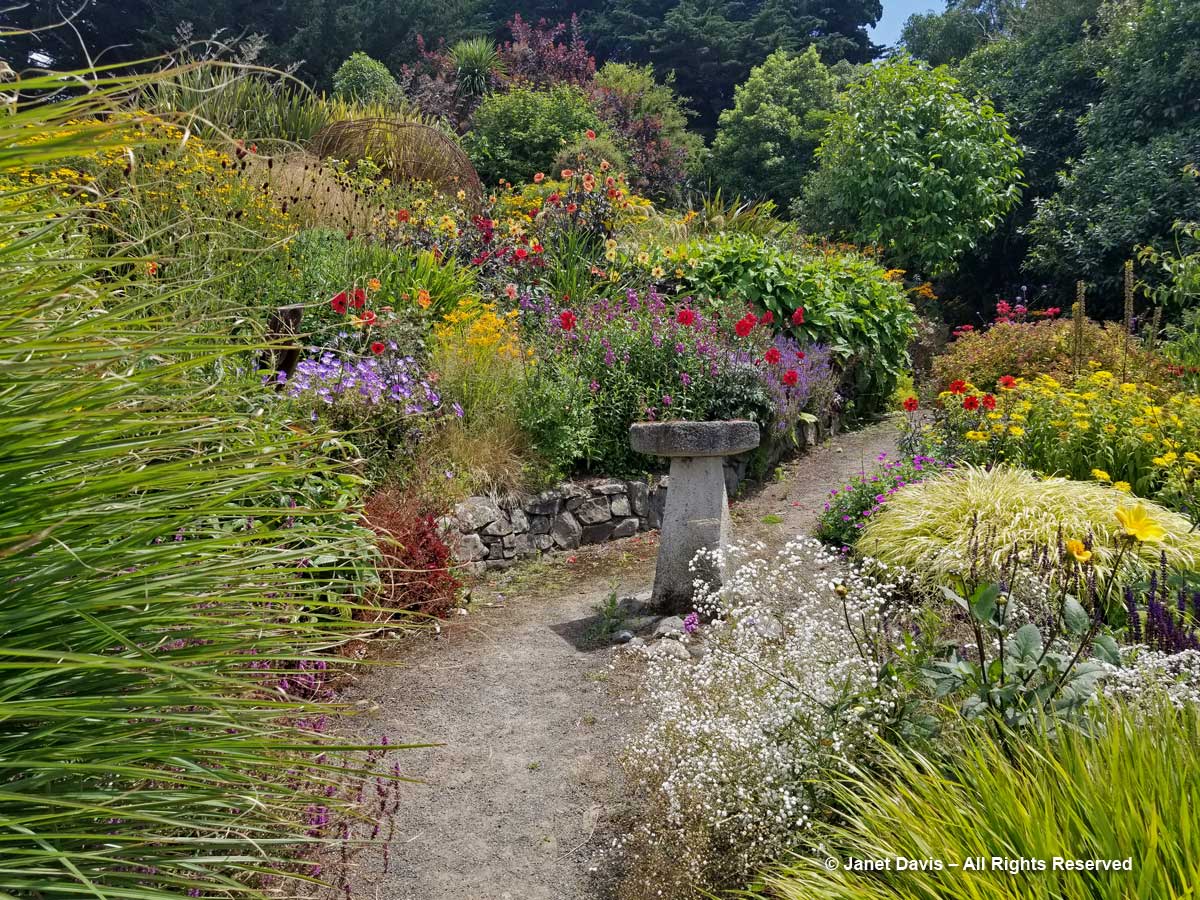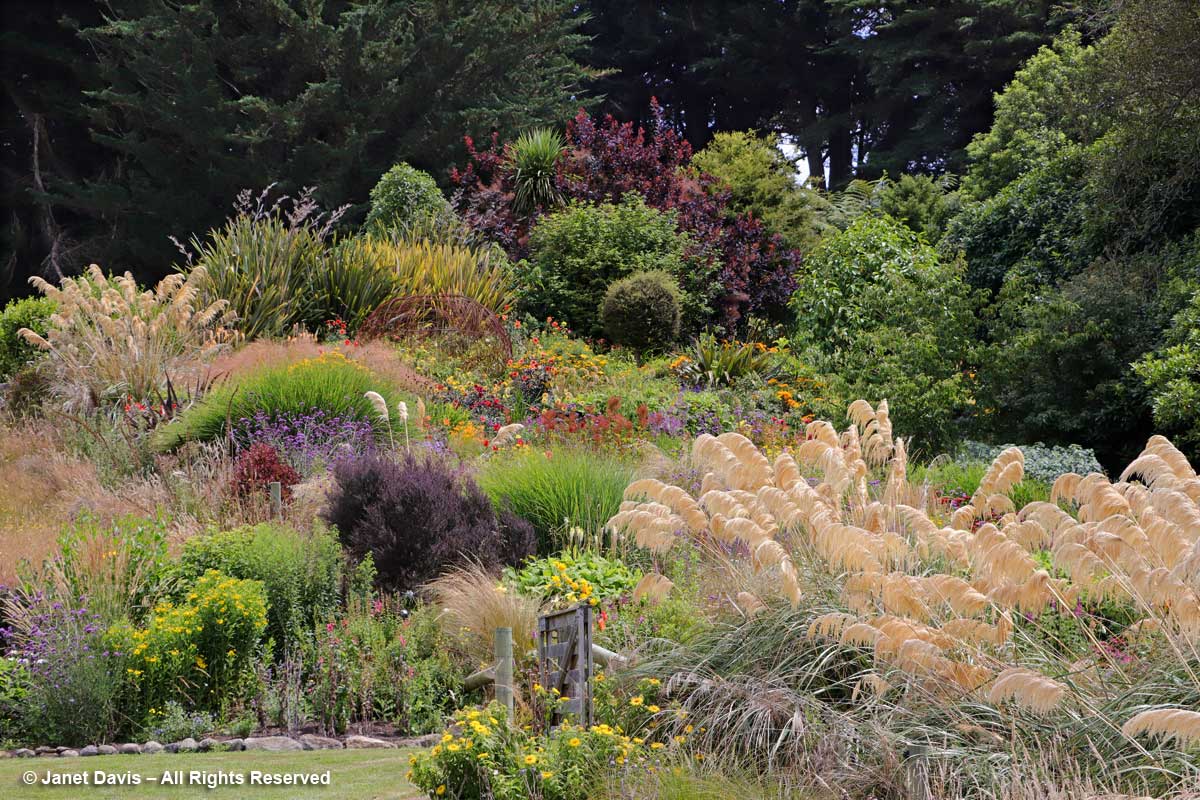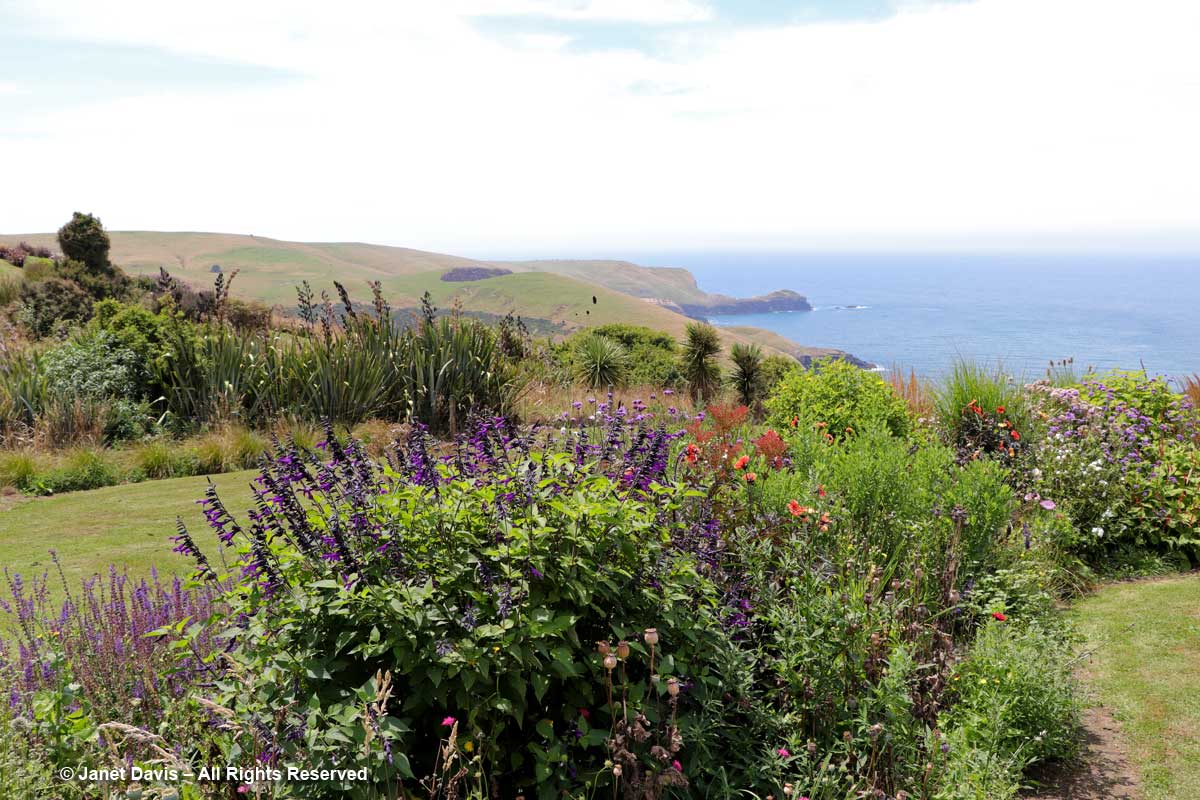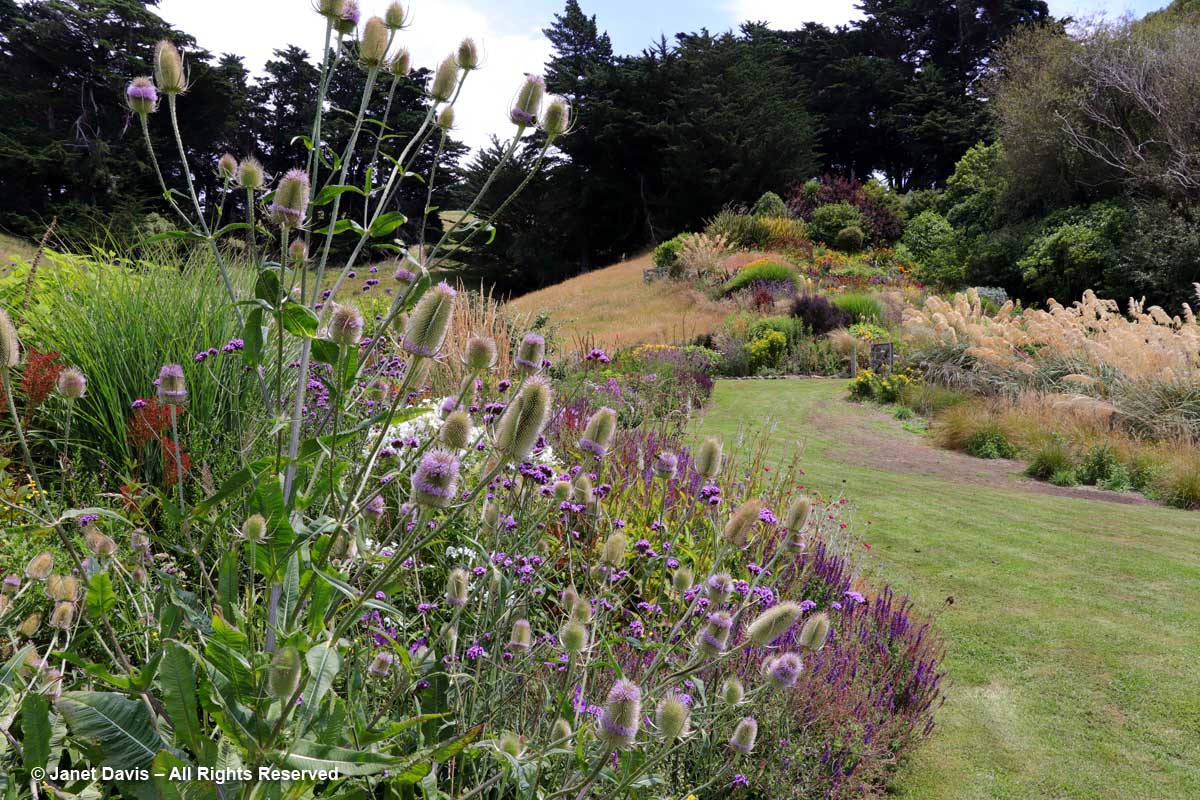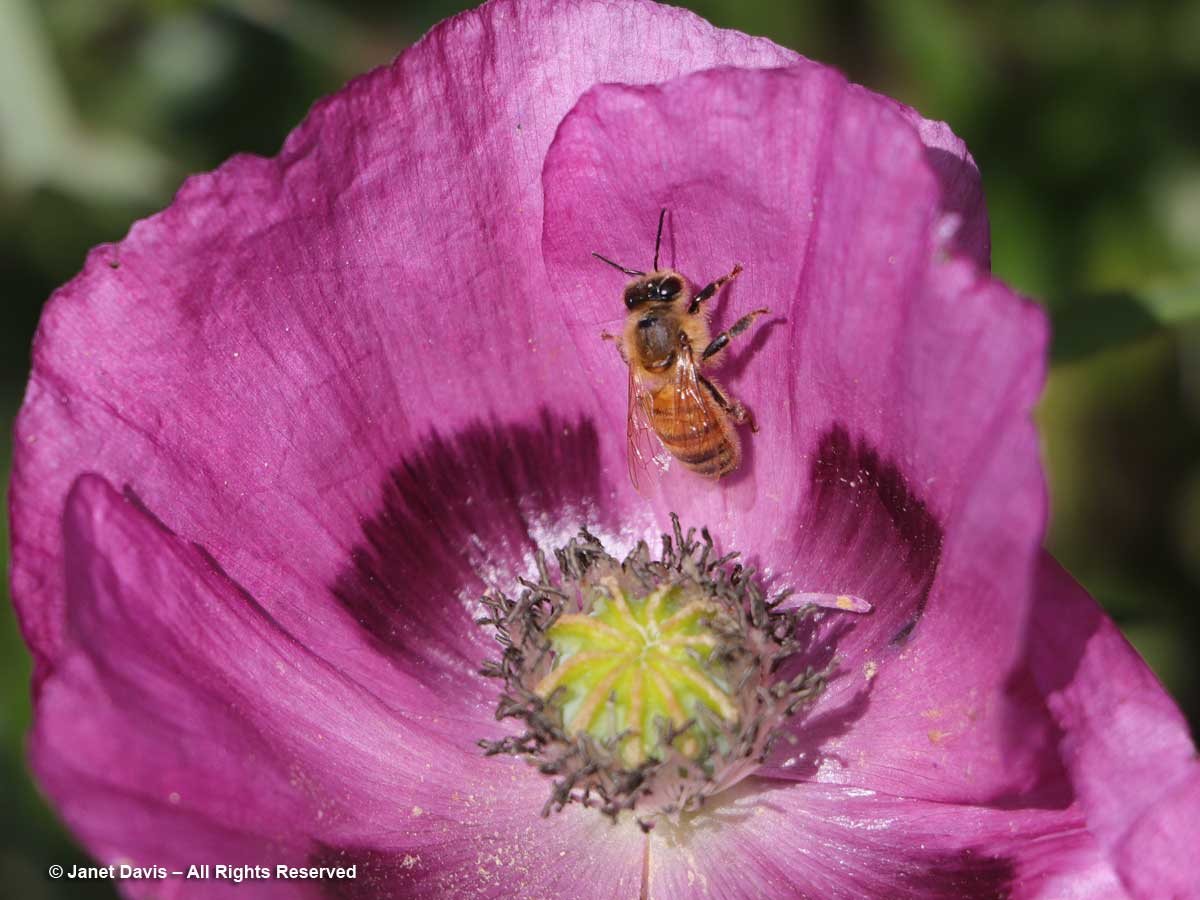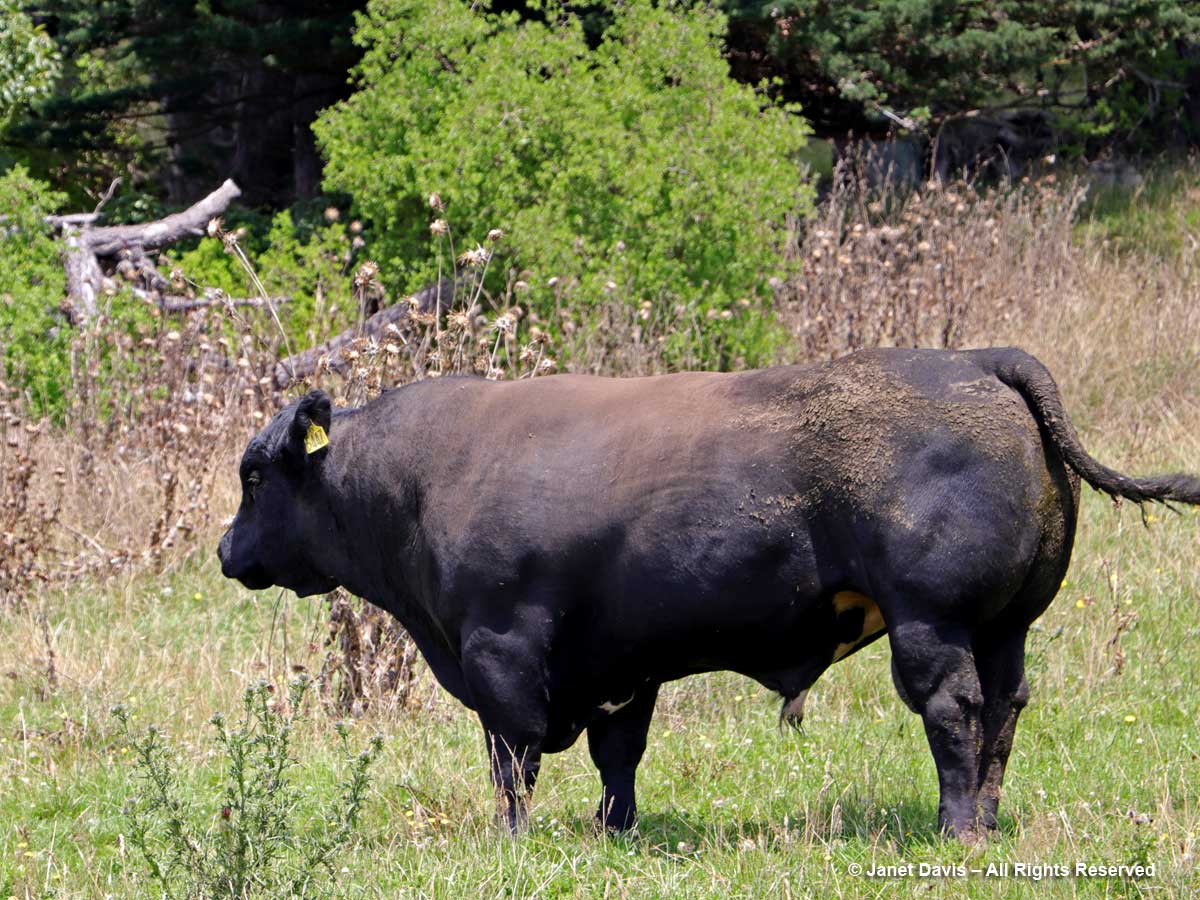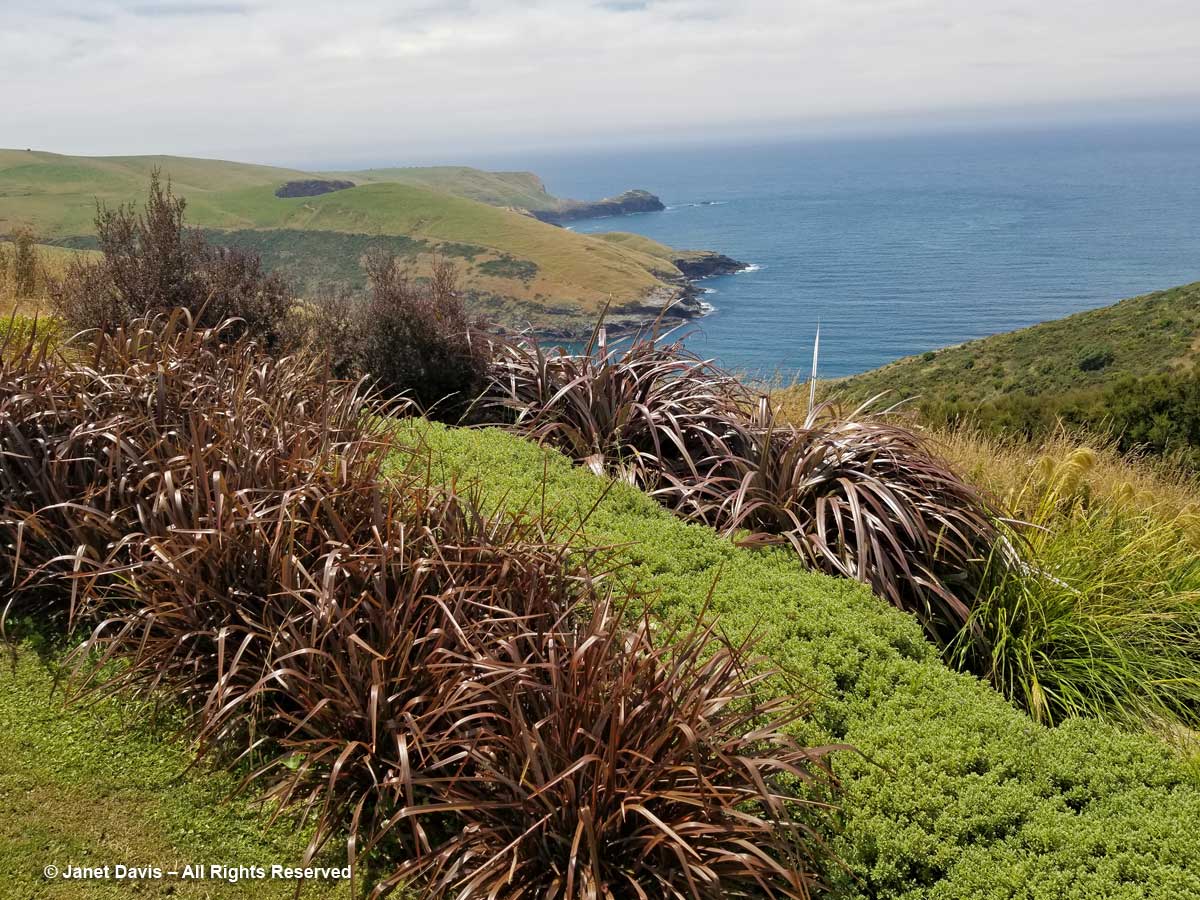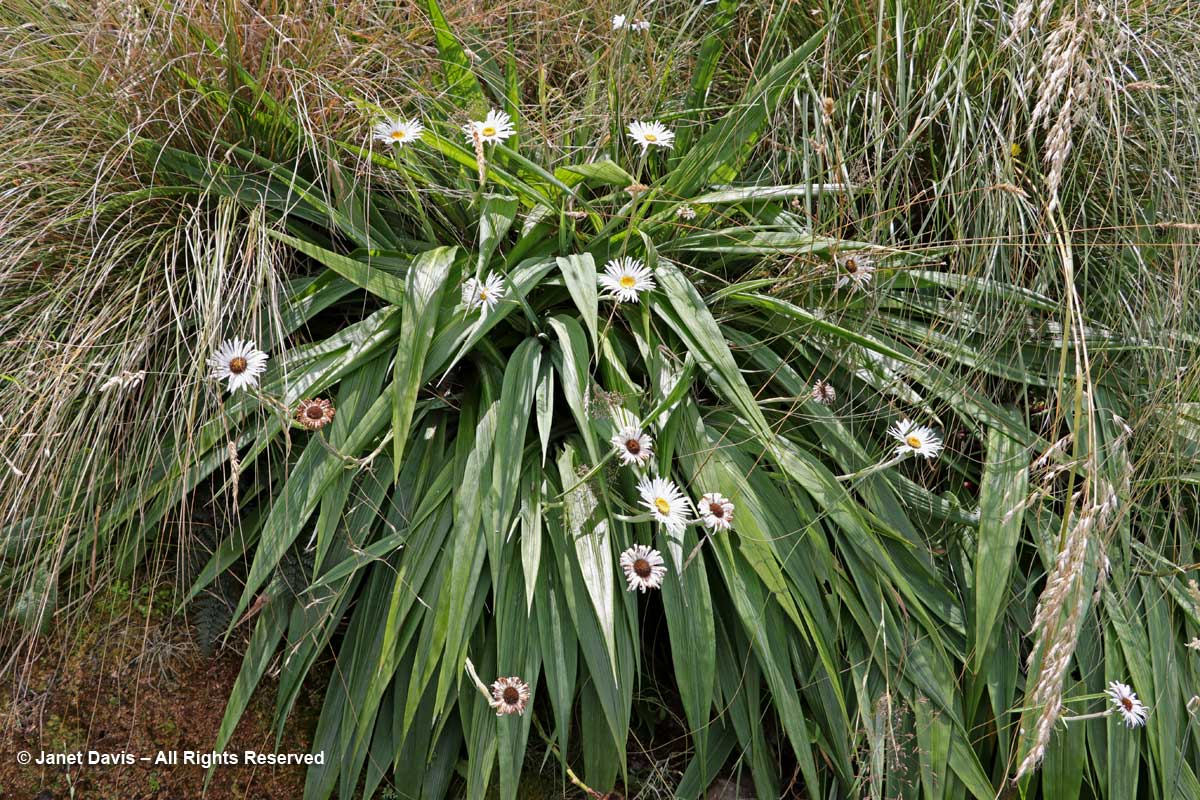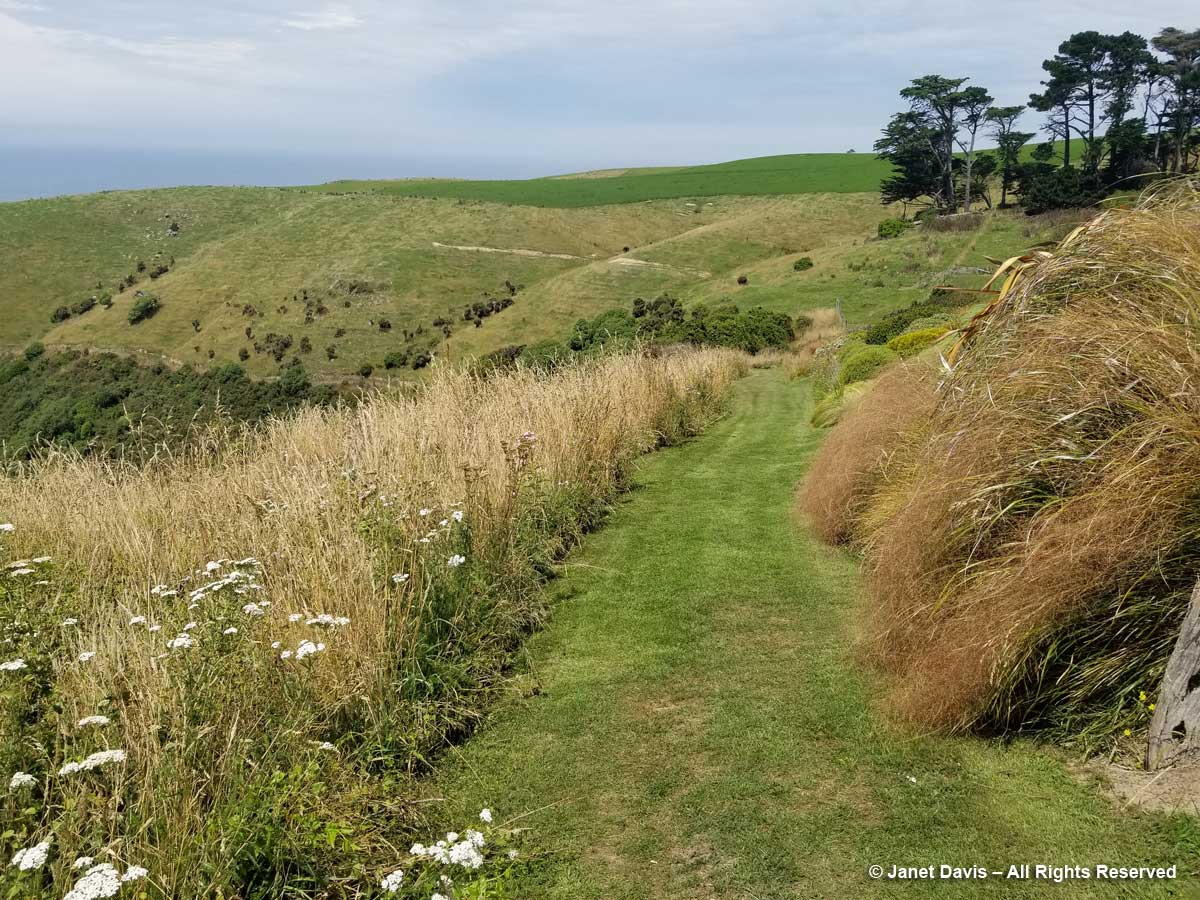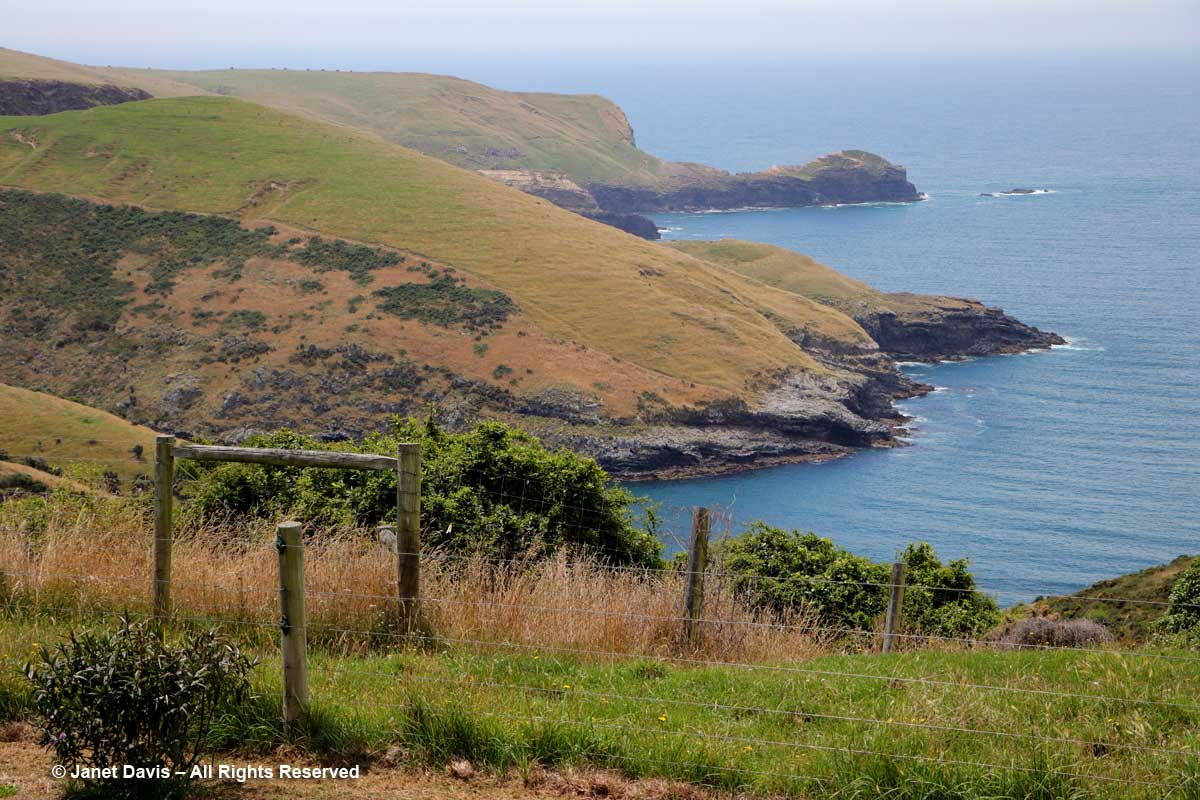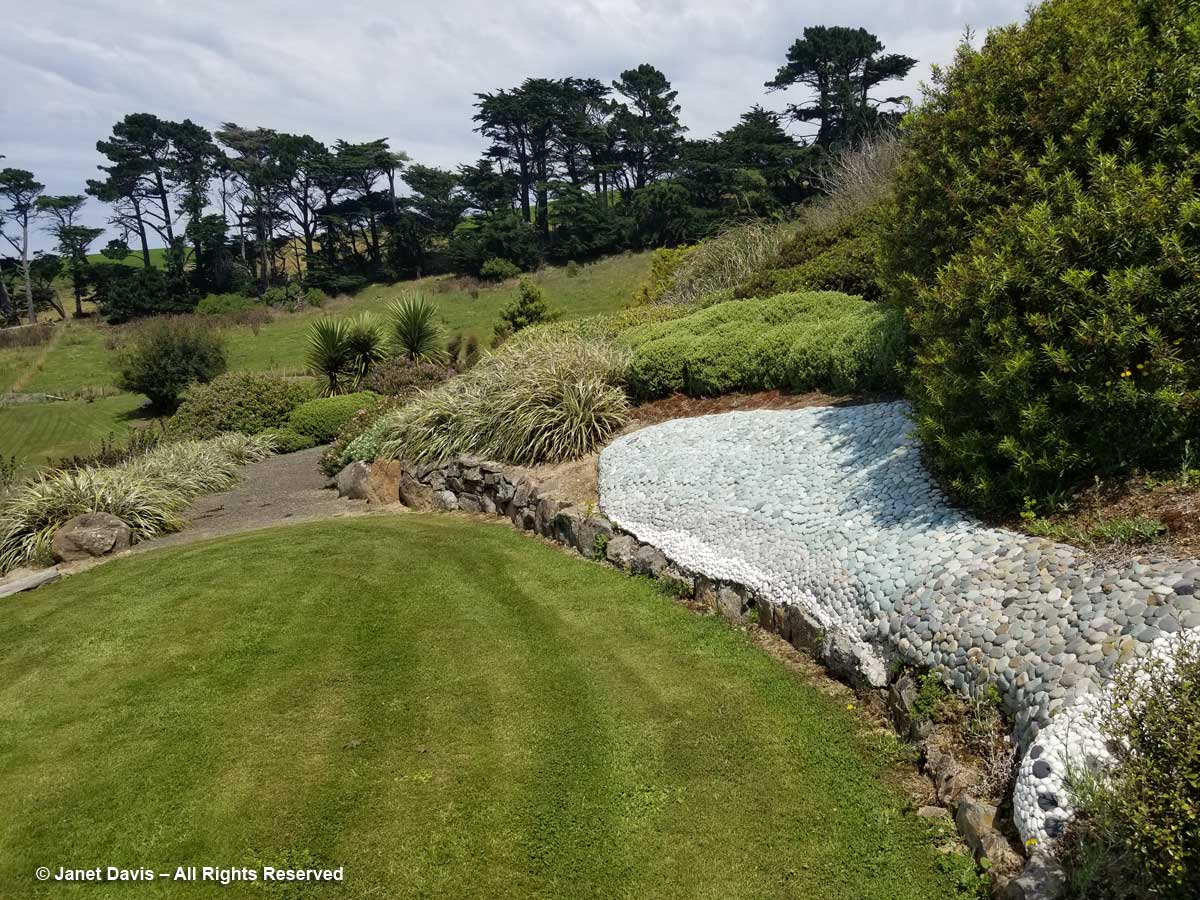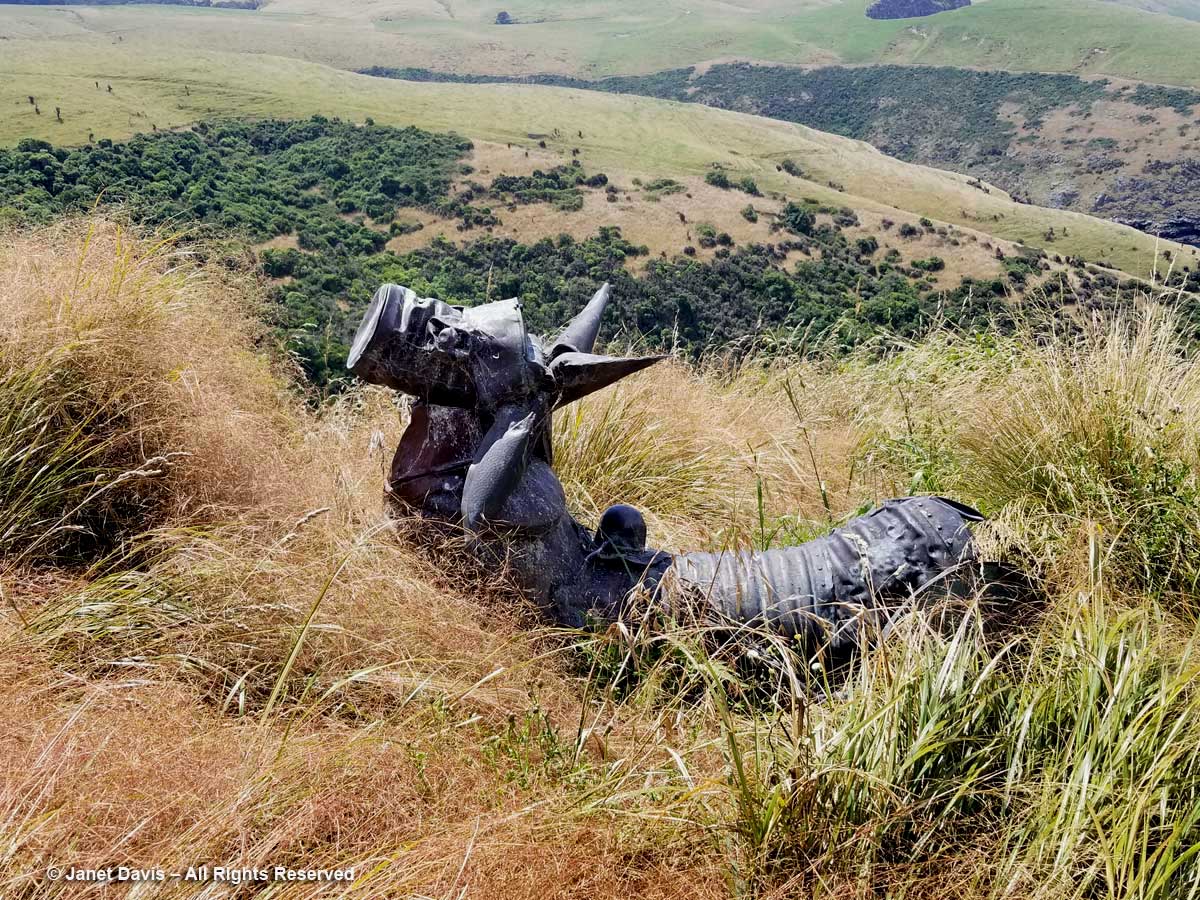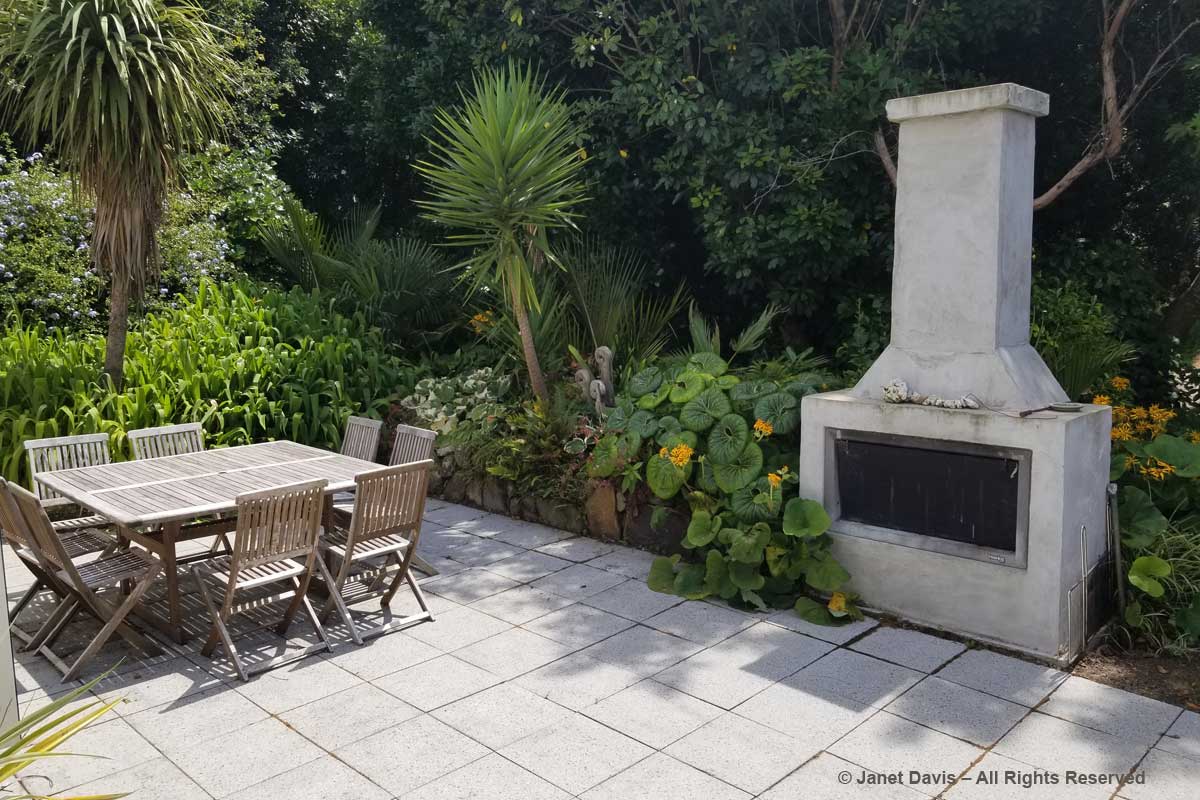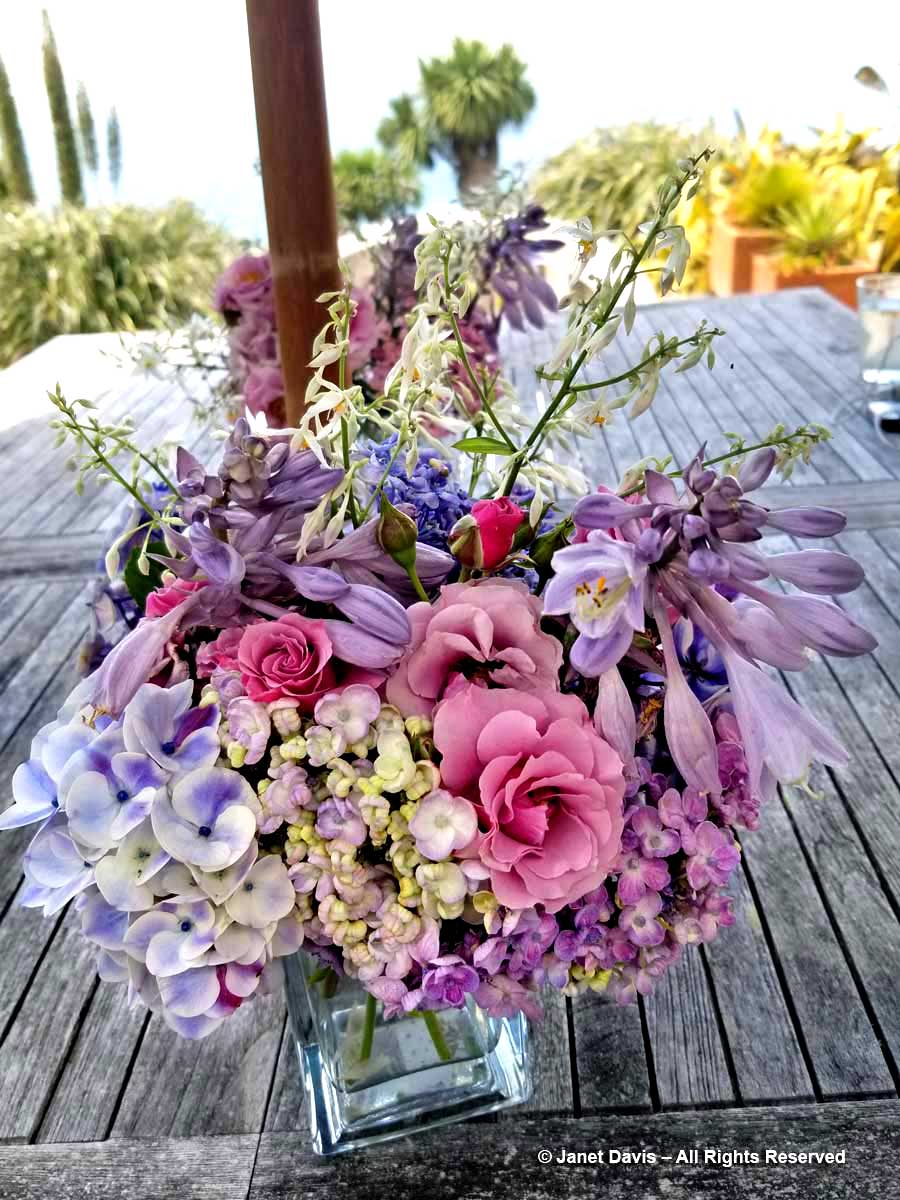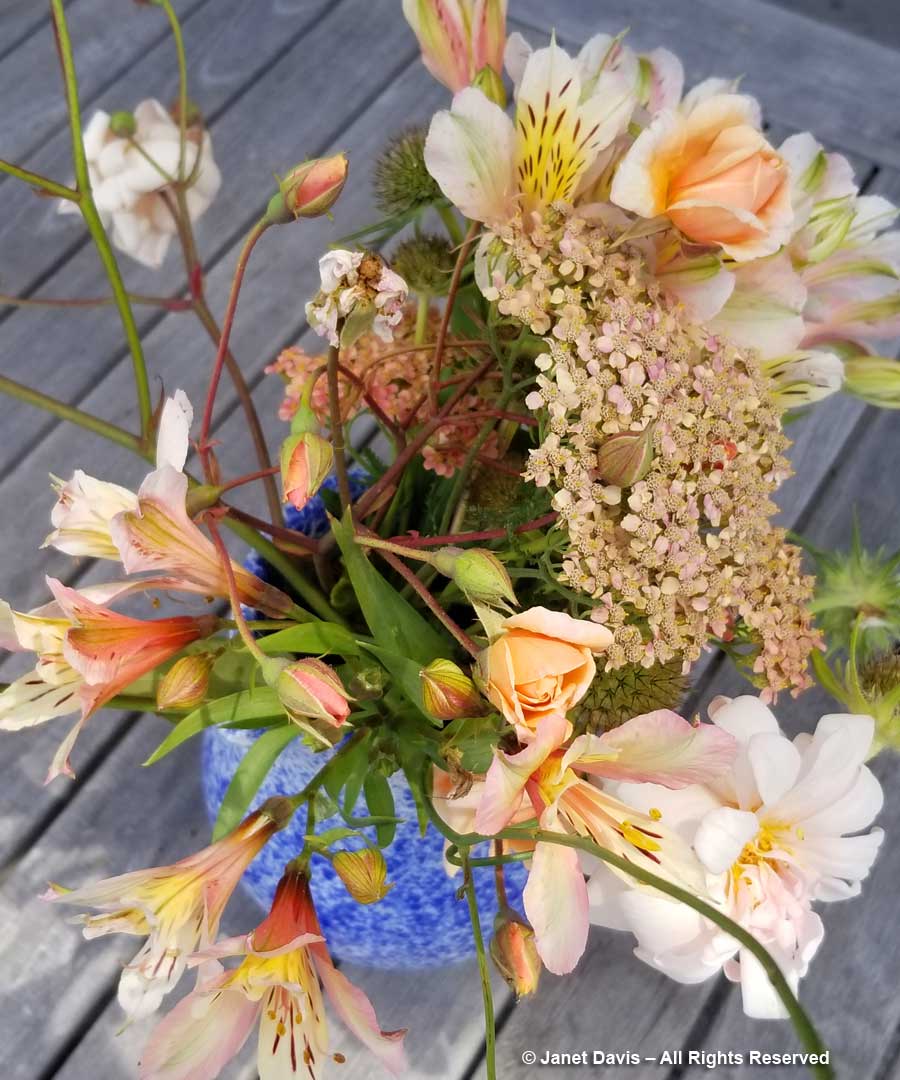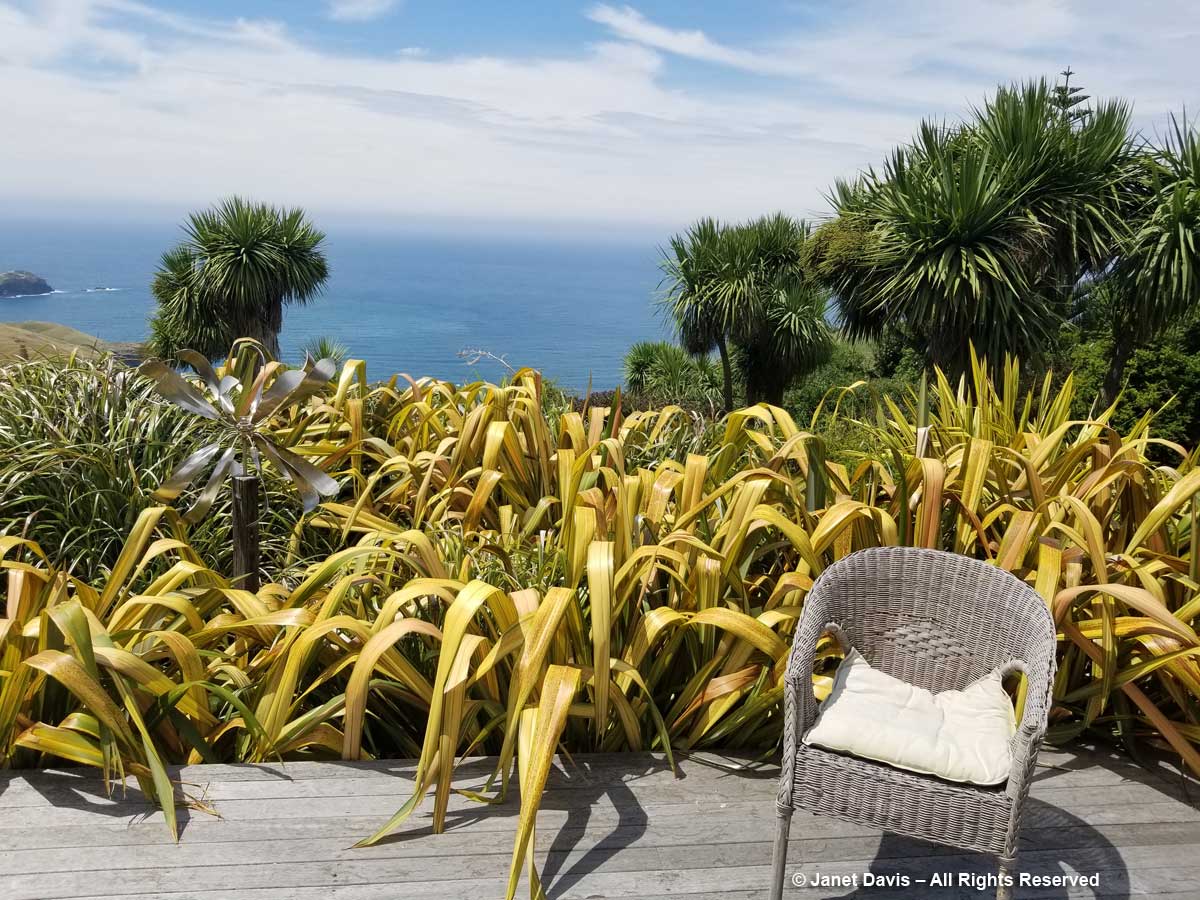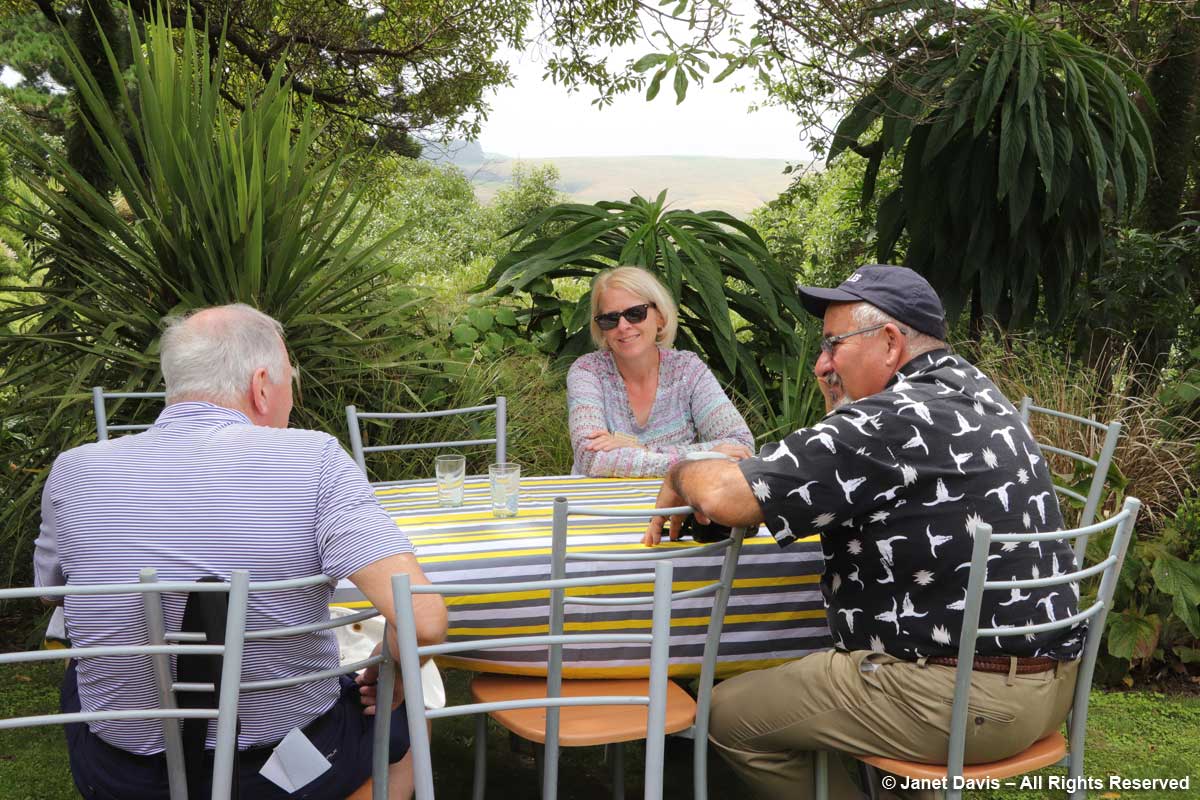Looking at a Google Maps satellite view of the Banks Peninsula is one thing, but driving the hilly landscape from garden to garden is quite another. We were now heading from Sir Miles Warren’s garden at Ohinetahi on Governors Bay (#1 below) to the “eastern bays” of the peninsula to visit Jill & Richard Simpson’s Fishermans Bay Garden (#2) and enjoy lunch there before ending our afternoon at The Giant’s House in Akaraoa (#3). (Click to enlarge the map.)
The drive to Fishermans Bay took us an hour and forty minutes and encompassed some of the most beautiful scenery we’d seen in New Zealand. A quarter-of-an-hour past Governors Bay, we drove past roadside stock pens and wild phormiums (P. tenax or harakeke).
We passed rocky outcrops at Gebbies Pass, below, that geologists call the “Gebbies Rhyolite”. It’s what’s left of volcanoes that occurred in the Late Cretaceous, around 81 million years ago. (And thank you to Dr. Greg Browne of GNS Science, New Zealand, for identifying the rock type for me.)
We climbed the hillside around Duvauchelle, from which some of the finest New Zealand woolens are exported around the world.
We passed olive groves near Robinsons Bay, home of a tasty, extra-virgin oil.
Then we came to our first sighting of the “eastern bays” — also known as the Wildside — a series of headlands and inlets jutting out from the peninsula into the Pacific. And I would be lying if I didn’t admit that this part of the trip was a little white-knuckle in a large bus, but we were soon…..
….. slowing down on a long access road, past the neighbouring farmer’s sheep running away…..
….. and beehives buzzing….
….. to park beside a rustic old shed framed in agapanthus and wildflowers…..
….. and be welcomed with a sign that we’d arrived.
We walked towards a pretty house with a little entrance garden featuring roses, Spanish lavender and an olive tree.
The owners of Fishermans Bay Garden, Jill and Richard Simpson, greeted us and gave a little introduction to the garden, which she later described to me as a “love story”. (You can hear her tell this story in the video at the end of this blog.) Jill was working as a landscape designer in Christchurch when they met and fell in love. A dairy farmer, Richard already owned the property – all 300 hectares (790 acres) of it, as well as a dairy farm in Springston west of Christchurch. They would bring their family of six children (three each) to the property for holidays. Once Jill’s children were old enough, they renovated the house and moved to the peninsula. That was 12 years ago, and Jill has been making gardens there ever since.
We began in the long double herbaceous border…….
……. with beautiful combinations of perennials and lots of fragrant lilies…..
….. and this spectacular rose, below, ‘Eyes for You’. It represents a remarkable and complex breeding achievement by Peter James, stemming from the dark-splotched Persian rose, Rosa persica – or, as some refer to it, Hulthemia persica. (In fact, the latest taxonomy places the parent in the rose Subgenus Hulthemia, so technically it’s correct to refer to the Persian rose as both names.) A straggly, yellow flowered rose native to dry areas in Iran and Afghanistan, it was that attractive blotch that captivated rose breeders. Some 40 years after they started working with it, there is a growing roster of roses with dark eyes and the Middle Eastern hulthemia in their bloodlines.
Jill collects hebes – more than 150 species and cultivars – and in fact has an entire garden of them, on the slope towards the ocean, but these two made attractive companions at the end of the border.
Fruit trees were integrated into the garden, including apples,…..
….. pears…
….. and plums (that were clearly providing nesting material for leaf-cutting bees)….
A vegetable garden was nearby, and this was one was designed for productivity….
…. rather than ornament.
There were some vestiges of the old holiday house that had once been here, like this sweet little patio.
I walked past an informal cottage garden with dahlias and roses towards a small forest of hulking Monterey cypress trees (Cupressus macrocarpa) – that exotic evergreen considered a pest in New Zealand and paradoxically in danger of extinction on California’s Monterey Peninsula, where it’s endemic.
There were interesting succulent plantings at the top of the hill here, with rusty old farm implements as decor……
…..and a fun planting of shaggy Acacia cognata ‘Limelight’.
I started down the path to find that this marked just the beginning of ……
……Jill’s newest garden, an ambitious hillside planted with an ebullient, Piet Oudolf-inspired tapestry of perennials.
Jill terraced this slope with two truckloads of railway ties, carted and placed one at a time. Let’s walk down through the garden together.
I could have spent hours exploring the plant combinations here. But it wasn’t simply a naturalistic meadow made by throwing all kinds of colourful perennials together; look at the way those carefully-placed canna lilies draw your eye through the planting here.
At the edges near the Monterey cypresses, conditions are favourable for native ferns and other shade-loving plants.
Moving further down, I saw a bench made from those very same cypress trees.
Further down the hill. Such an amazing profusion of flowers and foliage.
I arrived at a little terrace on the hillside, where there was a stunning piece of statuary conceived as an airy steel wire sculpture by Hawarden sculptor Sharon Earl, titled ‘Ecosphere’, from which to appreciate the amazing view.
And what a view it is.
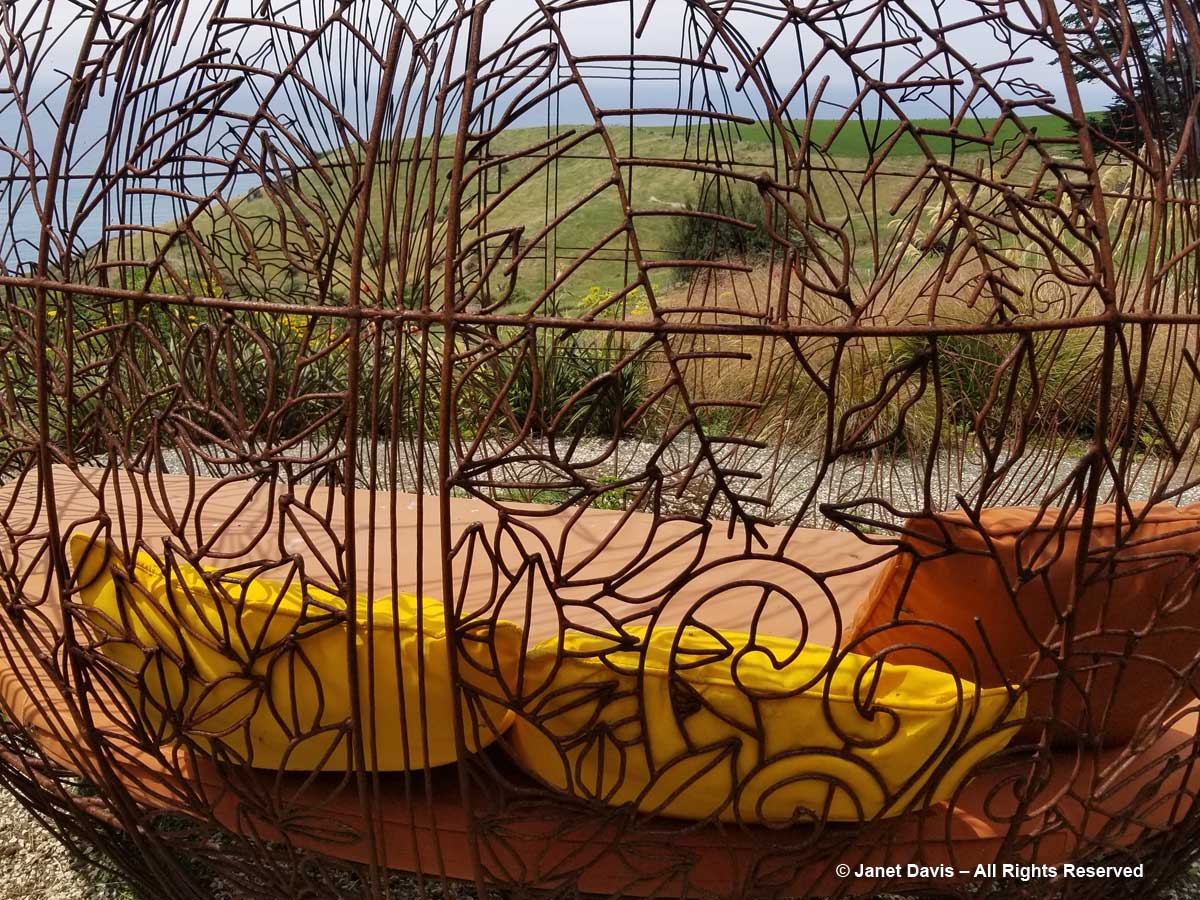
Let’s keep going down this flowery path, because there’s something very different at the bottom. (And I don’t mean the bellowing bull our tour members are photographing.)
This is from the same position, but looking back up the hill.
At the base of the hillside border, I looked back up. That fluffy waving flag of native New Zealand toetoe (Cortaderia richardsonii) on the right, below, represents a frontier on this property, and a shift from the ornamental plants grown all the way up the slope, …..
….. because although there was still a sinuous stream of traditional perennials extending towards the ocean,……
….. which culminated in a bee-friendly planting of Fuller’s teasel (Dipsacum fullonum)
….. and annual opium poppies (Papaver somniferum) adjacent to……
……the paddock with the very noisy bull,…..
…… we had now arrived in Jill Simpson’s next gardening chapter. Here is where her love of plants meets her ecological sensibility. After buying this property two decades ago, the Simpsons protected about one-third of it via covenanting, and much of the native ‘bush’ on their property has regenerated since then. (The Simpsons are founder members of the Banks Peninsula Conservation Trust). But New Zealand natives are also beautiful garden plants (as the international horticultural community has discovered), so Jill has begun to use natives and cultivars of native plants in her designs here near the Pacific, like the brown New Zealand flax (Phormium tenax) below.
But there are many pure natives here, like the totoe, below, with Chionochloa in front……
….. and the lovely cotton daisy (Celmisia spectabilis).
As I headed back towards the house along a track mown through meadows…
….. I gazed down at the ocean 150 metres (492 feet) below. Though I didn’t ask the Simpsons, I imagine that the bay is a popular fishing location. The southeastern bays are known for blue cod, sea perch, tarakihi and trumpeter fish.
I’m not sure what fish this was, adorning the entrance to Jill’s hebe collection. Rockfish?
I passed Herbina, the corrugated cow resting in the meadow grasses. I read that although Richard Simpson has had a long relationship with dairy cattle on his farms, he and Jill now have a sharemilker on their other property near Christchurch. (Sharemilking is often used in New Zealand to provide income to farmers who have given up their herds, while providing an opportunity to younger farmers with cattle, but no land). And their young next-door neighbour and his wife manage this property for them, leaving them free to garden and pursue new opportunities, such as their recent purchase of the old (1907) Madeira Hotel in Akaroa.
It was time to enjoy the lovely lunch, set out on the various patios and decks.
I loved the bouquets that Jill had made…
….. from her abundance of flowers.
Look at this view from my lunch spot! That phormium is ‘Jester’, and beyond are astelias and native cabbage trees (Cordyline australis).
These alfresco lunches in the special gardens on the tour were a chance for us to relax and get to know one another better. And it was fun for my husband, Doug, left, to get to know “my” friends from the gardening world, like North Carolina’s Cyndy Cromwell and Denver Botanic Garden’s Panayoti Kelaidis.
Jill Simpson was sitting with us on the deck, and someone asked her how this all got started. Her answer was candid and interesting — including the direction she hopes to take integrating native plants here at Fishermans Bay.
With less than a half-hour remaining before we had to depart for Akaroa, I finished my lunch and rushed back out to this amazing garden to see what I might have missed. It was then that I heard the mellifluous song of the New Zealand bellbird (Anthornis melanura), and I had an idea. What if I retraced my steps through as much of the property as I could, filming the beautiful garden while the bellbird sang in the background. Could I do it? Would the little yellow bird sing on cue? Have a listen and see what happened.

